11/13/2020 News & Commentary - National Security
News & commentary by Dave Maxwell. Edited and published by Duncan Moore.
1. Trump wasn’t wrong about China. But here’s how Biden can do a better job.
2. Outgoing Syria envoy admits hiding US troop numbers; praises Trump’s Mideast record
3. Political warfare: strategies for combating China’s plan to “win without fighting”
4. An "oh so social" conversation series courtesy of the OSS Society
5. Trump bars Americans from investing in firms that help China’s military
6. Joint statement from Elections Infrastructure Government Coordinating Council and Sector Coordinating Council executive committees
7. Department of Homeland Security calls election "the most secure in American history"
8. New DoD adviser has made controversial proposal: get rid of the Marine Corps
9. ‘A black eye’: why political polling missed the mark. Again.
10. Biden team reaching out to former Mattis officials for help with transition
11. New US Army museum opens on Veterans Day
12. Department of Defense announces cost of living increase to retired pay
13. Biden’s military brain trust includes former Navy, Marine Corps top leaders
14. All Sides news site
15. America’s biggest adversaries have been mostly silent on Biden’s election
16. Cambodian Defense Chief defends demolition of second US-funded building at Ream Naval Base
17. Coronavirus live updates: U.S. cases top 150,000 for first time
18. Pyongsan uranium mines: despite typhoons, mining and processing operations continue
19. Is China preparing to set up an ADIZ in the South China Sea with Taiwan in mind?
20. Pathfinder School at Fort Benning slated to officially get the ax
21. US military 'using private spy planes' to keep watch on China
22. MBA alumnus and U.S. Army veteran takes on military staffing company COO role amid COVID-19 outbreak
23. Myths about vote tampering could persist for years, say experts
24. The next decade could be even worse
1. Trump wasn’t wrong about China. But here’s how Biden can do a better job.
Washington Post · Stewart Baker · November 12, 2020
There is probably better advice than the very first paragraph. This should be sent to all members of the transition team. Although it may be counterintuitive to many and many may be blinded by partisan politics, there is a lot in the national security realm that should be continued. The bottom line is the incoming administration needs to not throw the baby out with the bathwater and it needs to avoid the idea that all ideas that do not come from the Biden team are not good.
2. Outgoing Syria envoy admits hiding US troop numbers; praises Trump’s Mideast record
Defense One · Katie Bo Williams · November 12, 2020
Managing personnel numbers in a complex environment is a real challenge. I feel for all the J1 personnel officers in all the units. Force caps and number constraints are some of the worst things to impose on any operation!
3. Political warfare: strategies for combating China’s plan to “win without fighting”
USMCU · Kerry K. Gershaneck · November 2020
I just received notice today the Marine Corps University Press just published this new report. Of course, I have not read it yet, but, based on my quick scan, I think it could be a useful report.
4. An "oh so social" conversation series courtesy of the OSS Society
Note: you rarely get 5 icons of the national security world together for a talk like this (Vickers, Gates, Panetta, McRaven, and Petraeus in the last one of the 5 video talks). I highly recommend this series (truth in advertising, I am in one of them). Click on the individual images at the link to watch.
5. Trump bars Americans from investing in firms that help China’s military
Wall Street Journal · Gordon Lubold & Dawn Lim · November 12, 2020
This is interesting.
6. Joint statement from Elections Infrastructure Government Coordinating Council and Sector Coordinating Council executive committees
National Association of State Election Directors · November 12, 2020
Of course, this will not mean anything to everyone. I am sure it will be dismissed as someone's propaganda.
7. Department of Homeland Security calls election "the most secure in American history"
Axios · Shawna Chen · November 12, 2020
8. New DoD adviser has made controversial proposal: get rid of the Marine Corps
Military.com · Richard Sisk & Gina Hawkins · November 12, 2020
I hope he has a good security detail (tongue in cheek).
9. ‘A black eye’: why political polling missed the mark. Again.
New York Times · David Leonhardt · November 12, 2020
Perhaps no one will ever trust polling again.
10. Biden team reaching out to former Mattis officials for help with transition
Politico · Lara Seligman · November 12, 2020
Of course, the Biden team will write new NSS and NDS documents. However, the current ones have some very good and important concepts. I hope the Biden team will keep the fundamentals of the NSS and NDS in the next iterations.
11. New US Army museum opens on Veterans Day
Voice of America · Deborah Block · November 11, 2020
I look forward to seeing this.
12. Department of Defense announces cost of living increase to retired pay
US Department of Defense · November 12, 2020
1.3%
13. Biden’s military brain trust includes former Navy, Marine Corps top leaders
Military.com · Gina Harkins · November 12, 2020
Personnel is policy and policy is personnel.
14. All Sides news site
Someone flagged this web site for me. It is a very interesting presentation of the news with each major story having a link to the left, right, and center.
15. America’s biggest adversaries have been mostly silent on Biden’s election
FDD · Thomas Joscelyn · November 12, 2020
Kim Jong-Un will be disappointed that he is not mentioned along with China, Russia, and Iran. He is probably working on a new love letter.
16. Cambodian Defense Chief defends demolition of second US-funded building at Ream Naval Base
Radio Free Asia · Khmer Service, Samean Yun, & Joshua Lipes · November 10, 2020
The Defense Minister doth protest too much.
17. Coronavirus live updates: U.S. cases top 150,000 for first time
Wall Street Journal · David Hall · November 13, 2020
Can we get a handle on this?
18. Pyongsan uranium mines: despite typhoons, mining and processing operations continue
38 North · Peter Makowsky, Frank Pabian, & Jack Liu · November 12, 2020
Everything to do with nuclear weapons and missiles and conventional military modernization continues in North Korea.
19. Is China preparing to set up an ADIZ in the South China Sea with Taiwan in mind?
Diplomat · Lu Li-shih · November 13, 2020
Types of aircraft intruding in Taiwan’s Southwest Air Defense Identification Zone reveal PLA intent.
20. Pathfinder School at Fort Benning slated to officially get the ax
Army Times · Kyle Rempfer · November 12, 2020
Oh no! The school with the most coveted and best-looking badge!
21. US military 'using private spy planes' to keep watch on China
9News · Richard Wood · November 13, 2020
This kind of information could put all kinds of private aircraft and non-standard aviation at risk.
22. MBA alumnus and U.S. Army veteran takes on military staffing company COO role amid COVID-19 outbreak
University of South Carolina · Clair McGrath · November 11, 2020
Another great American with whom I have had to the honor of serving.
23. Myths about vote tampering could persist for years, say experts
Defense One · Patrick Tucker · November 12, 2020
Nothing will convince those who believe these myths.
24. The next decade could be even worse
Atlantic · Graeme Wood · November 12, 2020
A depressing read. I hope his iron laws will rust and crumble.
"Riches are apt to betray a man into arrogance."
-Joseph Addison
"The truest characters of ignorance are vanity, and pride, and arrogance."
- Samuel Butler
“There are many men of principle in both parties in America, but there is no party of principle."
- Alexis de Tocqueville
USIP Publications - 11/13/2020
https://www.usip.org/blog/2020/11/vietnam-veterans-fight-dignity-and-peace
A Vietnam Veteran’s Fight—for Dignity and Peace
By James Rupert
War put a bullet in John Lancaster’s spine. He turned that into a life’s work of compassion.
In 1967, America was racing the Soviet Union into space, debating war in Vietnam and dancing to Aretha Franklin’s “Respect.” John Lancaster graduated that spring from the University of Notre Dame. Having studied on a Navy ROTC scholarship, he took a commission in the Marine Corps. After several more months of training, Second Lieutenant Lancaster landed at Da Nang airport amid the Vietnam War’s bloodiest battle: the 1968 Tet Offensive by the North Vietnamese and Viet Cong forces.
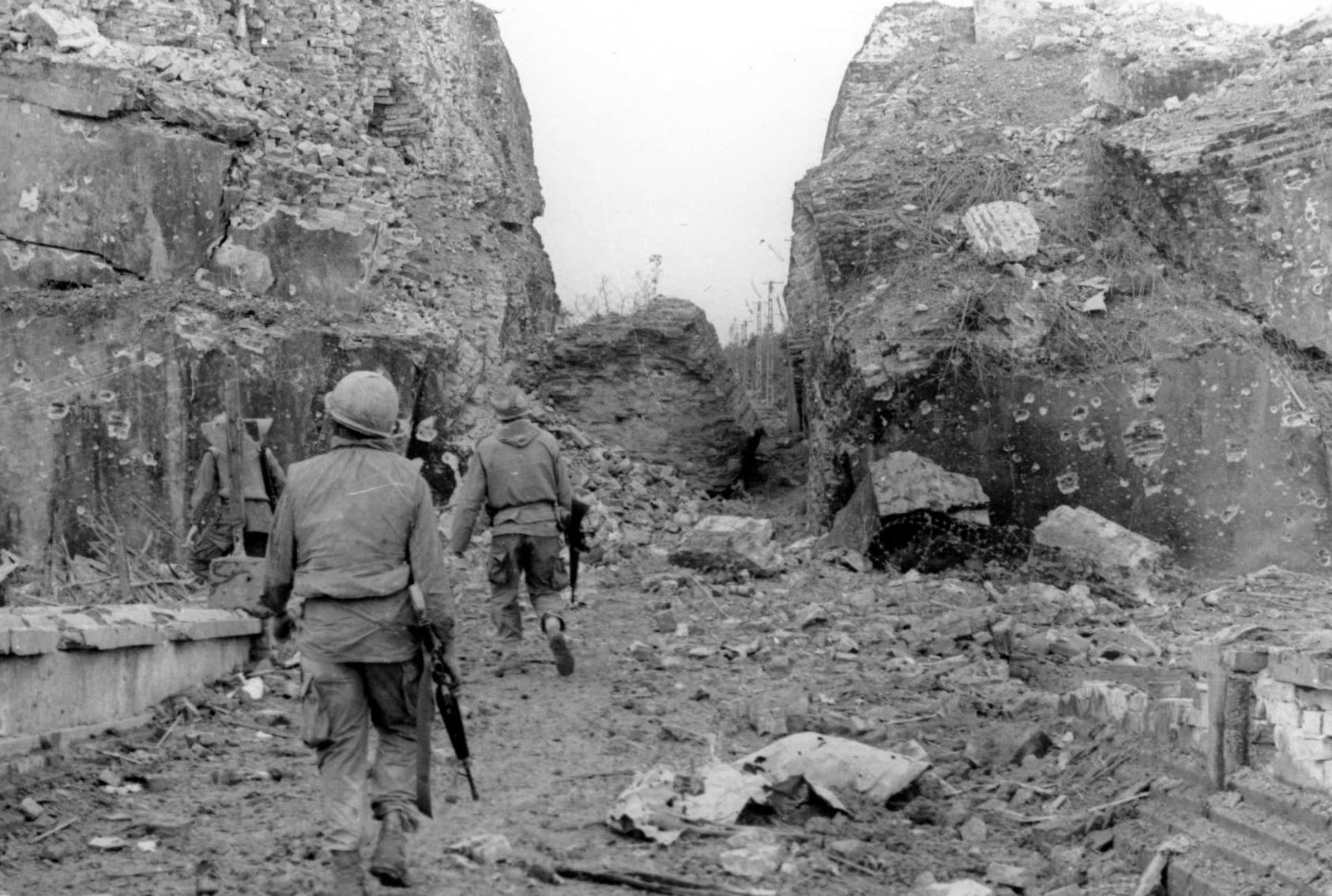
A Veterans’ Day Story
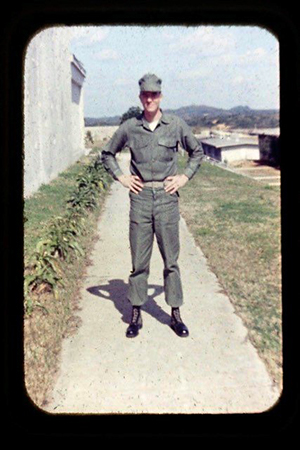
In response to Tet, the military was rushing new forces into combat, including a shipload of Marines who had been conducting goodwill exercises around Asia. “I had been in-country all of 10 days and I was assigned a platoon of guys from the 1/27 Marines. Most of them were 18-year-olds; I was 23.” Lancaster issued his troops new M16 rifles and soon led them into a flat landscape of rice paddies, canals and mostly abandoned villages near the city of Huế.
Dug into farmland on a dark night, Lancaster’s troops heard first a shrill blast of whistles as a large force of North Vietnamese attacked. “They came running in with guns blazing, throwing satchel charges and grenades,” Lancaster recalled in an interview. “They got inside us real quick because they were willing to take the casualties.” The battle raged for hours. Amid smoke, muzzle flashes and explosions, Lancaster heard injured Marines call for help and leapt up. In a sprint to the Marines’ foxhole, Lancaster “came face-to-face with an enemy soldier,” another Marine wrote. Before Lancaster could aim his rifle, the North Vietnamese soldier fired.
A bullet tore through Lancaster’s chest, ripping holes in both lungs. Another shattered his spine. Minutes later, Marines dragged Lancaster out of gunfire and “a really good corpsman figured out which lung he could plug up,” Lancaster recalled. “He rolled me onto my side to let me breathe, gave me something to hold onto and warned me that to survive I had to resist the shock, stay conscious and not let myself roll onto my back.”
In five hours of chaos, Lancaster’s platoon of 32 suffered four Marines killed and 18 wounded. One of the dead, Lancaster said, was “a guy I had wanted to leave in the rear; he had only a week left before he was due to return home to his wife and two kids.”
Just five days later, U.S. and North Vietnamese diplomats would hold their first meeting in the Paris peace talks to end the war. John would spend months in hospitals, returning to America with the Purple Heart, the Bronze Star and a life to rebuild. “I lost a lot of really good Marines. … It took me a while to get over that day, I’ll tell you, and to get my life back together.”
Disability Rights: The Longer War
Lancaster’s next battle would last not hours, but decades. He decided to follow his father’s career path as a lawyer and applied to Notre Dame’s law school. In his interview with the two senior deans, “it was clear that they didn’t want to take me,” Lancaster said. “I’ll never forget Dean Fascio looking right at me and saying, ‘John, you don’t understand. We’re literally out of seats this year in the first-year class.’ And I said, from my wheelchair, ‘Not to worry, dean, I’ll bring my own.’ Then he asked, ‘How are you going to get up the steps into the building?’ And I said, ‘the same way I got in for this interview. I’m gonna corner a couple of beefy students and ask them to pull me up.” He added: “By the way I notice there are plans for a new wing on the law school and I fully expect it will be completely accessible to people with disabilities under the recently passed standards of the Architectural Barriers Act of 1968.” The deans let him in.
Over years, potential employers dismissed John’s ambition as though reading from a script: “How can you deal with the courthouse steps?” “The law library stacks are too narrow for you; how will you do research?” Or simply, “We don’t think you’ll have the stamina to work in our office.” Finally, Lancaster won his first legal job at the Veterans Administration, “poring over case files in a in a gray office with other guys wearing gray suits and gray complexions.”
So when a prominent disability rights campaigner, Judith Heumann, and another Marine vet, James Maye, rolled their wheelchairs into his office one day, Lancaster seized on their invitation to join the movement as a lawyer for the Paralyzed Veterans of America. “They were building a network of people with disabilities to take on big, basic issues like access to jobs and transportation,” he said. The work would include battling the too-automatic institutionalization of people, notably with developmental and health disabilities. “I toured some pretty ugly facilities in that job,” and “I met a whole bunch of veterans who had paid a high price for war.”
That, plus some work representing indigent prisoners at Washington, DC’s jail, fueled Lancaster’s mission. Over seven years he drafted and helped implement Maryland state laws protecting legal rights of people with disabilities. He then moved to the center of the nation’s disability rights revolution. Under the George H.W. Bush and Clinton administrations, Lancaster worked in a small White House office to help Americans understand and implement the 1990 Americans With Disabilities Act—the landmark law that prohibited discrimination in employment and public accommodations against people with disabilities. “We toured all 50 states, explaining the law to the business community, to vocational rehabilitation services and to people with disabilities,” Lancaster said. In each city, “we would hold a big reception to bring everybody together. It was amazing how often the head of the state vocational rehabilitation agency had never even met the head of the chamber of commerce. There was an amazing disconnect between those preparing people with disabilities for the world of work and those who had the jobs!”
Then one day, a quarter-century after Lancaster took a couple of North Vietnamese bullets in a rice paddy, a Vietnamese-American man “just showed up in my office.” Ca Van Tran explained that he was building a campaign to help Vietnamese disabled in the war. “I hear you’re a Vietnam veteran,” Tran said. He asked: Would John help the men he once fought?
Reconciliation in Vietnam
Lancaster won backing from U.S. officials and made several trips to help Tran advocate for disabled Vietnamese. Soon, he moved from his White House job to a city whose very name had once been an American epithet for evil: Hanoi. Through a nonprofit organization, Vietnam Assistance for the Handicapped, Lancaster spent nearly five years working in support of men whom war had once defined as his enemies.
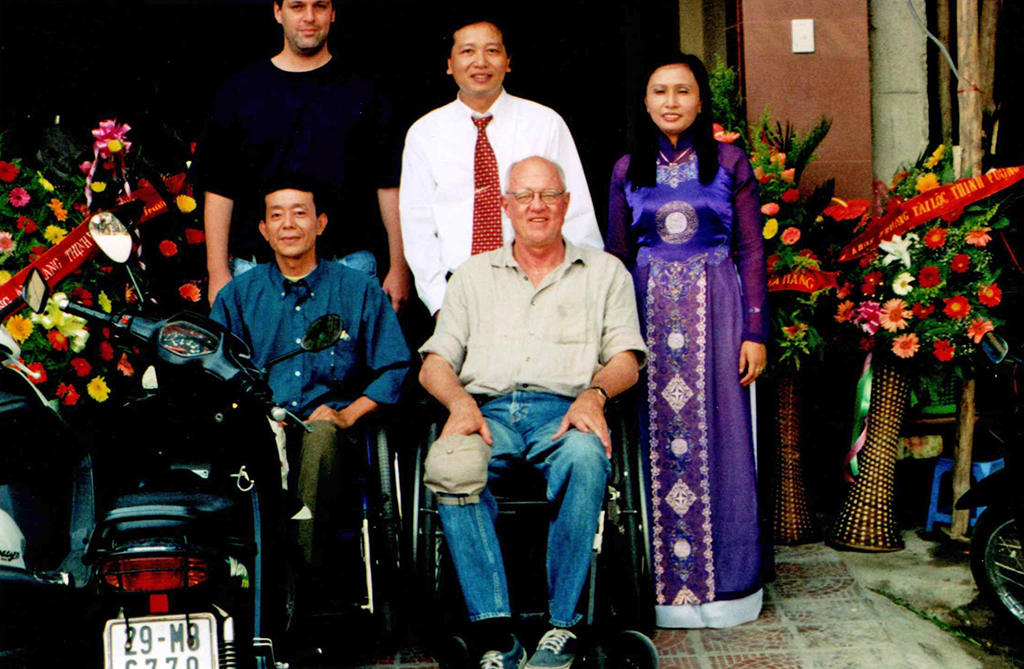
“One of my best friends in Vietnam is a disabled North Vietnamese army vet who heads, no kidding, the ‘Disabled Veterans Sports and Singing Club’ in Hanoi,” said Lancaster. “When they weren’t playing wheelchair basketball or tennis, they were a choir performing Vietnamese patriotic and folk songs. … Manh Tuan had a motorbike that had been adapted into a three-wheeler with a platform on the back big enough for me to ride along. So we would go around the city together on his motorbike.” Manh Tuan was disabled “the same way I was—with a bullet in the spine”—and in the same place, fighting for those rice paddies east of Hue in May 1968. “We figured out that we never personally fought against one another,” Lancaster said, “but we were injured doing exactly the same thing for opposing sides.”
“The Vietnamese government was pretty good at making positive changes,” Lancaster said. “They recognize how widespread disabilities are in Vietnam from what they call ‘The American War.’ We spent time in three-quarters of Vietnam’s provinces. And what is most horrific is the new casualties and disabilities being inflicted on innocents.” Monitoring organizations have counted more than 100,000 Vietnamese killed, disabled or hurt since the war’s end by tons of unexploded bombs and shells decaying in Vietnam’s soils and waters. The Vietnamese Red Cross estimates that 3 million of the country’s people, including 150,000 children suffer cancers, birth defects or other disabling ills from the poisonous defoliant Agent Orange.
Veterans and the Costs of War
On Veterans Day, what meaning should we take from a story like John Lancaster’s story? Partly, it’s an answer to the question “What are the costs of war?”
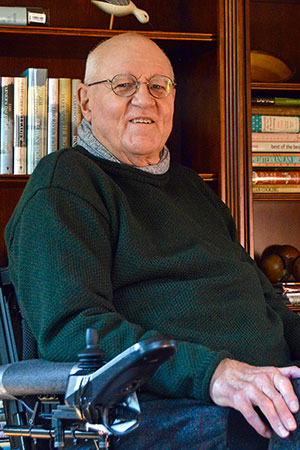
Economists, neurologists, demographers and others dig ever deeper to answer that question with data. Research from Brown University’s Costs of War project, Australia’s Institute for Economics and Peace and the Carnegie Commission’s Costs of Conflict has deepened the evidence for what Lancaster tells us from experience: Whatever we may we see and understand of war’s costs is a fraction of the reality.
Too, Lancaster’s story is a reminder that some of our most committed peacebuilders are warfighters. When Americans campaigned decades ago to establish a specialized “institute of peace” to strengthen our nation’s ability to prevent wars, combat veterans led that movement. They included senators (and World War II lieutenants) Mark Hatfield of Oregon and Spark Matsunaga of Hawaii. A leader at the grass roots was former Navy ensign Mike Mapes, who had witnessed nuclear war at Nagasaki.
Lancaster helps oversee USIP’s work as a member of its Board of Directors—a role that he says helps him close a circle. Like the many other war veterans among the Institute’s staff and partners, Lancaster labors to prevent violence because he knows, better than most people, its costs. Also like USIP, Lancaster works with the certainty that—even where the violence has been brutal and the trauma deep—reconciliation and peace are always possible.
https://www.usip.org/blog/2020/11/how-art-helped-propel-sudans-revolution
How Art Helped Propel Sudan’s Revolution
Artists helped spur conversations about the trajectory of the country, develop a shared vocabulary and organize protests.
During Sudan’s 2019 revolution—as people mobilized across the country with sit-ins, marches, boycotts, and strikes—artists helped capture the country’s discontent and solidify protesters’ resolve. In particular, artists became an integral part of the months-long sit-in at the military headquarters in Khartoum, which was known as the heart of the revolution until it was violently dispersed by paramilitary forces on June 3, 2019. This immense expression of creativity was both a result of loosening restrictions on freedom of expression and, at the same time, a catalyst for further change.
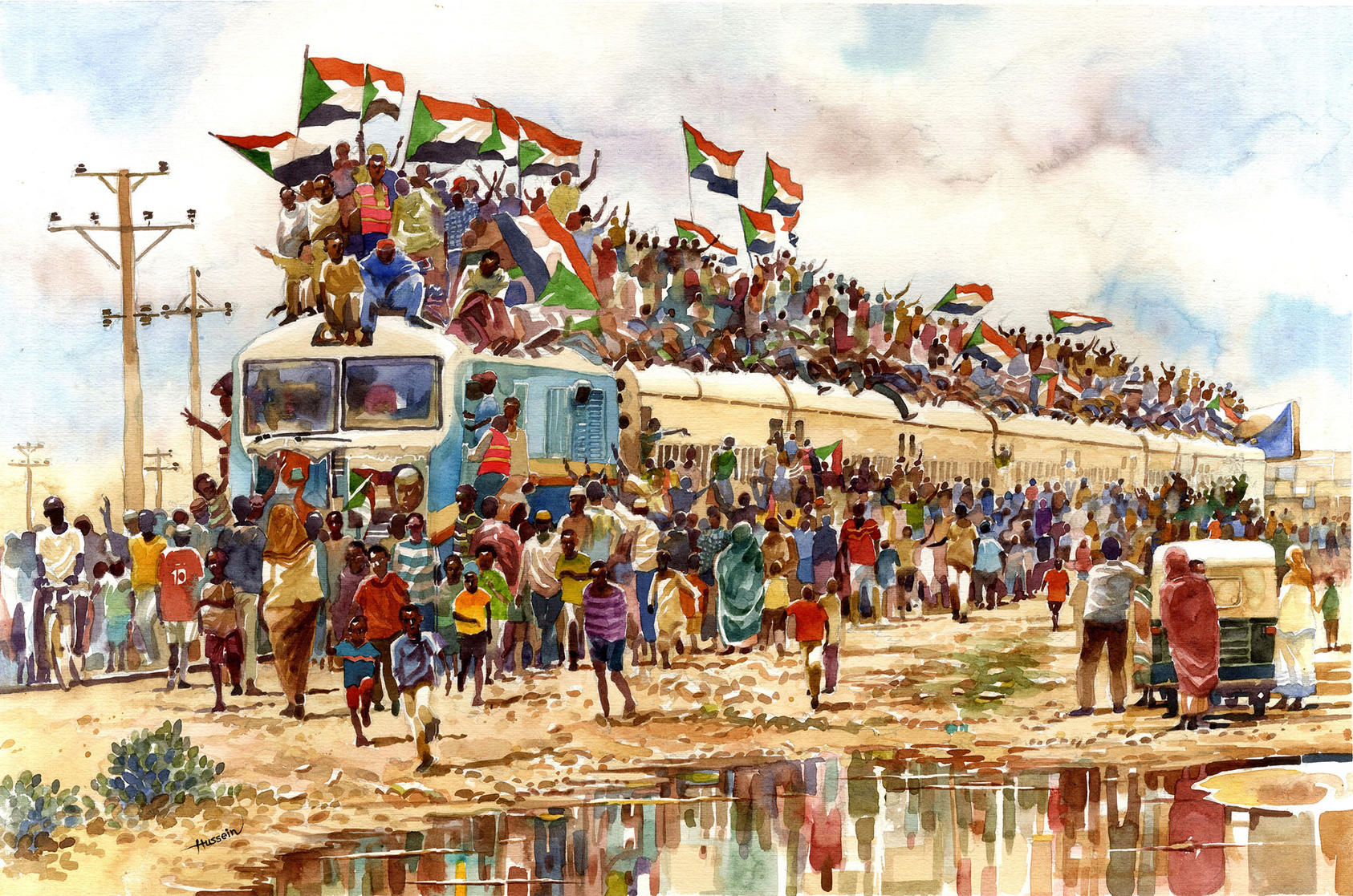
Throughout Sudan, artists helped spur on conversations about the trajectory of the country and also used murals to share information about dates and times of protests. (See Special Envoy Donald E. Booth’s video statement here.) Jonathan Pinckney, program officer and research lead for USIP’s program on nonviolent action, points out that art has played a role in many major nonviolent struggles as a way to create a shared vocabulary: “Art can provide a unifying center for the many different specific goals and agendas … Few people may read a movement’s hundred-page manifesto, but everyone can recognize the colors, songs, and images that movements draw upon to tell their supporters who they are and what they want."
As for Sudan’s artists themselves, Mustafa Abushamma, owner and founder of Khartoum’s Mojo Gallery, says that the revolution brought a new generation of artists to prominence: “When the revolution happened … the whole world was seeing these amazing murals on the walls in Sudan.” (See USIP’s interview with Mustafa Abushamma here.)
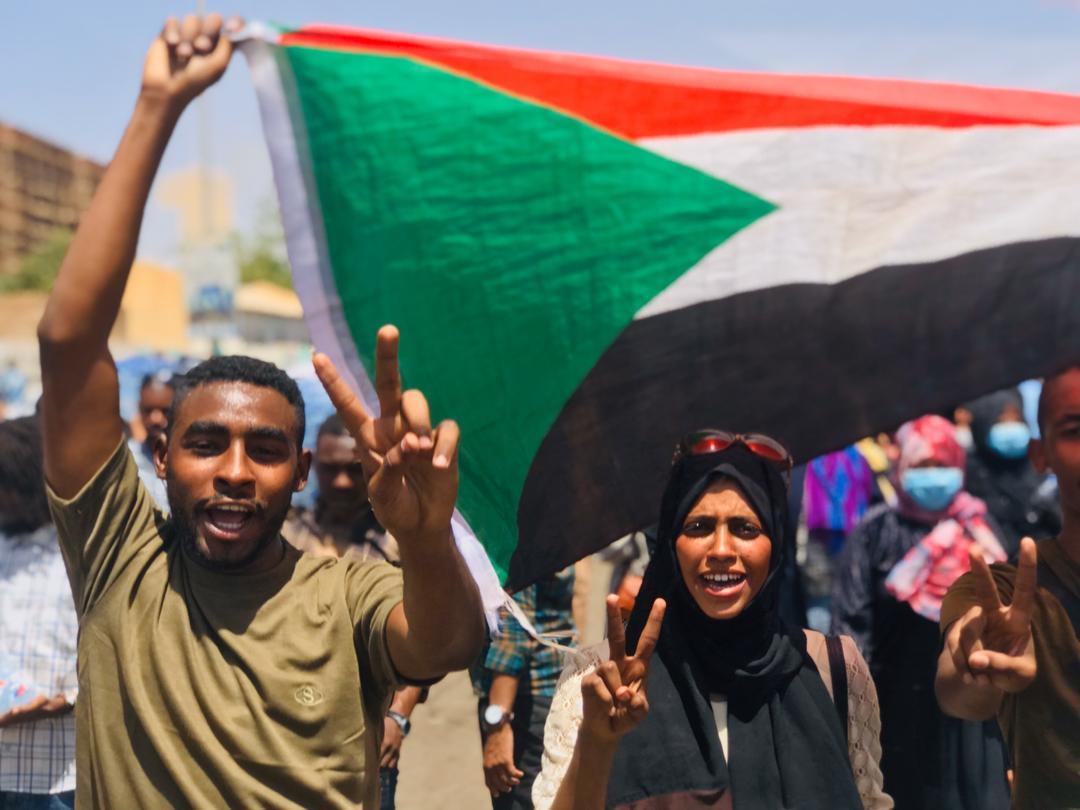
Murals: Keeping Eyes on the Revolution
One of the first forms of art to pop up during the revolution were outdoor murals. As protesters flooded the streets, so too did art installations that depicted a wide array of topics.
Graffiti artist Assil Diab, known as Sudalove, created murals across Khartoum to honor the martyrs of the revolution and of the regime of Omar al-Bashir. Assil describes her work as “a medium to start dialogues and conversations with the community and also speak on behalf of so many people,” noting that upon seeing a mural, “whether you’re with or against the revolution, you are forced to be reminded of what is going on.” (See USIP’s interview with Assil Diab here.)
Families of Sudanese martyrs have found some catharsis in watching or even assisting Assil Diab in creating murals honoring their loved ones. For Pinckney, this comes as no surprise, as “there is something powerful about art that touches the emotions, expresses shared humanity, and invites the participation of lots of people.”
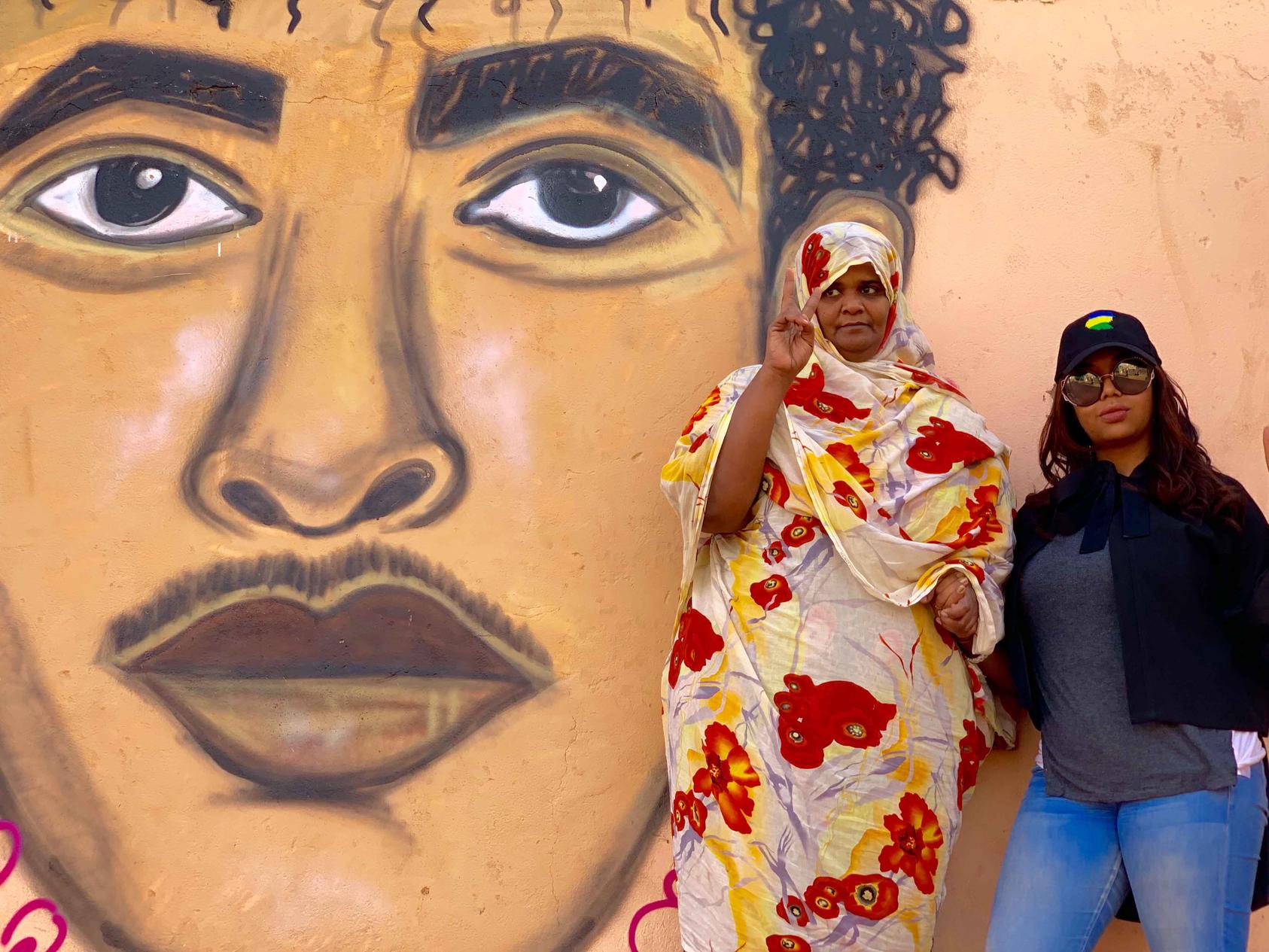
Galal Yousif is internationally recognized for his work across many mediums, including murals. Throughout the revolution, he created several large artworks at well-trafficked locations in Khartoum, including the widely admired mural “The Scream” that was destroyed during the violent crackdown on the Khartoum sit-in.
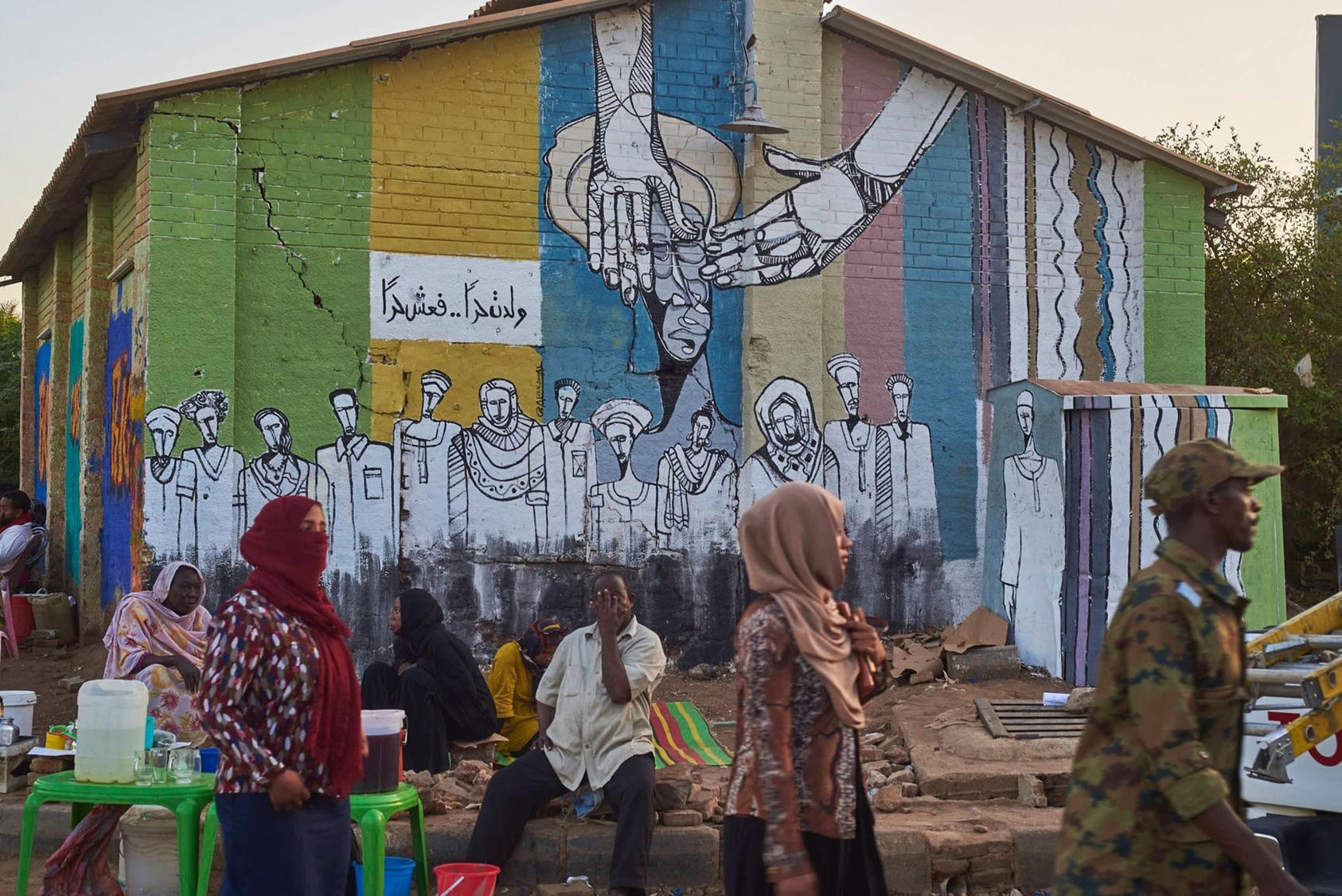
Although he has been asked to repaint “The Scream,” Yousif maintains that the mural was part of the massacre and that he will not recreate it until there has been justice for the lives lost. Transitional justice is one of the foremost challenges facing the Sudanese government, and many Sudanese are frustrated by the lack of progress to date. Beyond “The Scream,” Yousif has painted other prominent murals in Sudan, including one near the sit-in site and another that he created under Mak Nimr Bridge in Khartoum with a team of volunteers.
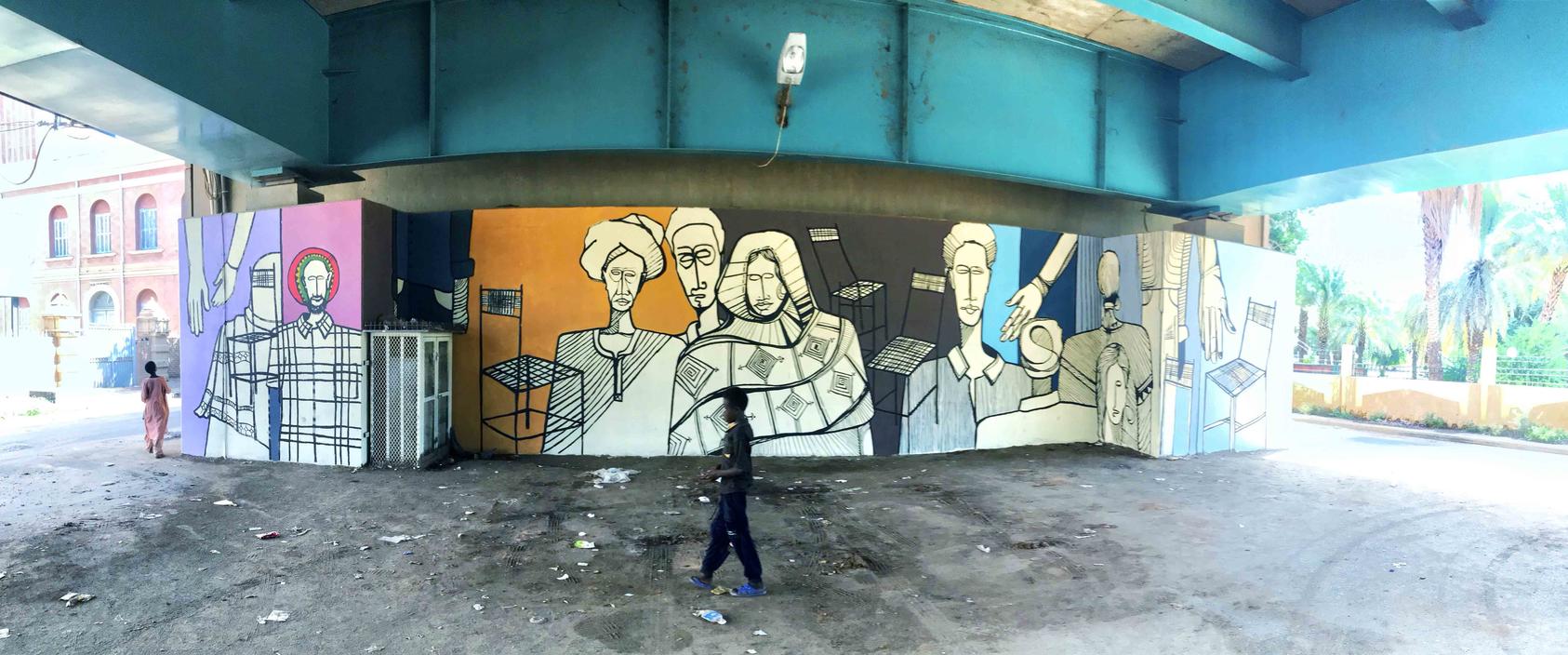
Meanwhile, artist Alaa Satir’s murals in the Burri neighborhood of Khartoum highlighted the prominent role of women in the revolution, including a mural of three women captioned “We are the revolution and the revolution continues.” After playing a pivotal part in organizing and leading protests, women have been mostly sidelined during the transitional period—signaling the need for further progress.
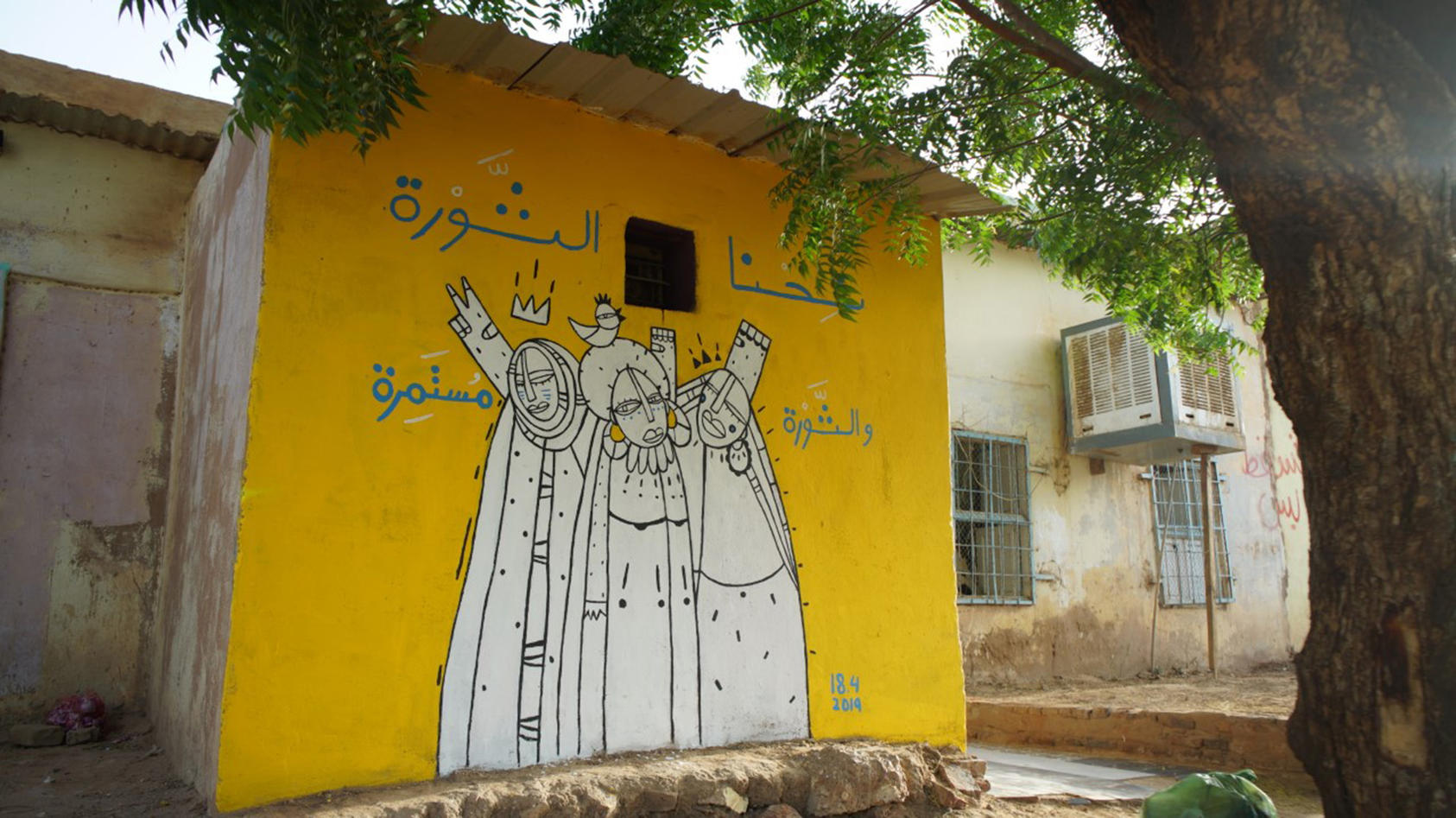
Virtual Art: Expanding the Revolution Beyond Sudan’s Borders
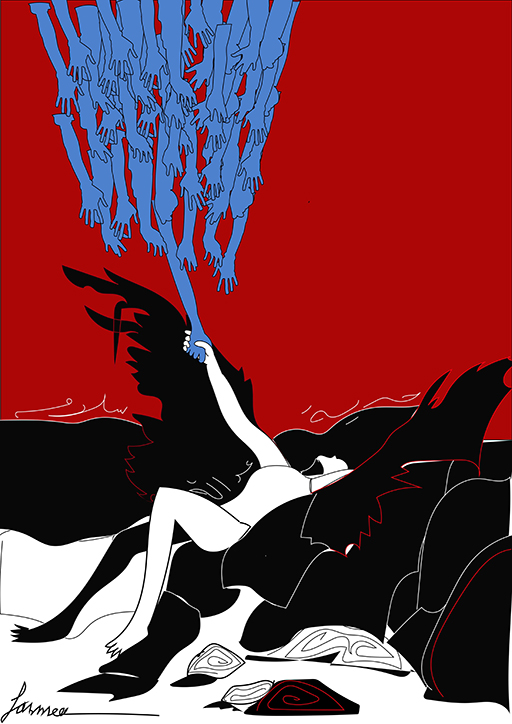
Within Sudan, online communication was a critical tool for organizing during the revolution, although efforts were hampered by government-initiated internet outages and blockages of key sites. But for those outside of Sudan—including artist Yasmeen Abdullah—social media campaigns allowed them to express their support. The most widely publicized of these campaigns was “Blue for Sudan,” in which users turned their profiles blue in solidarity following the killing of activist Mohamed Hashim Mattar during the Khartoum military headquarters sit-in crackdown on June 3, 2019.
Digital art also opened the doors to experimentation with new mediums. Dubai-based artist Merghani Salih created massive photo mosaics composed of images from the revolution. Describing his process of creation, Merghani said: “I found myself building an archive with all the daily images and videos which were being shared across all social media channels from across Sudan. I then contemplated that if a picture is worth a thousand words, what if that picture was physically made up of one thousand images?”
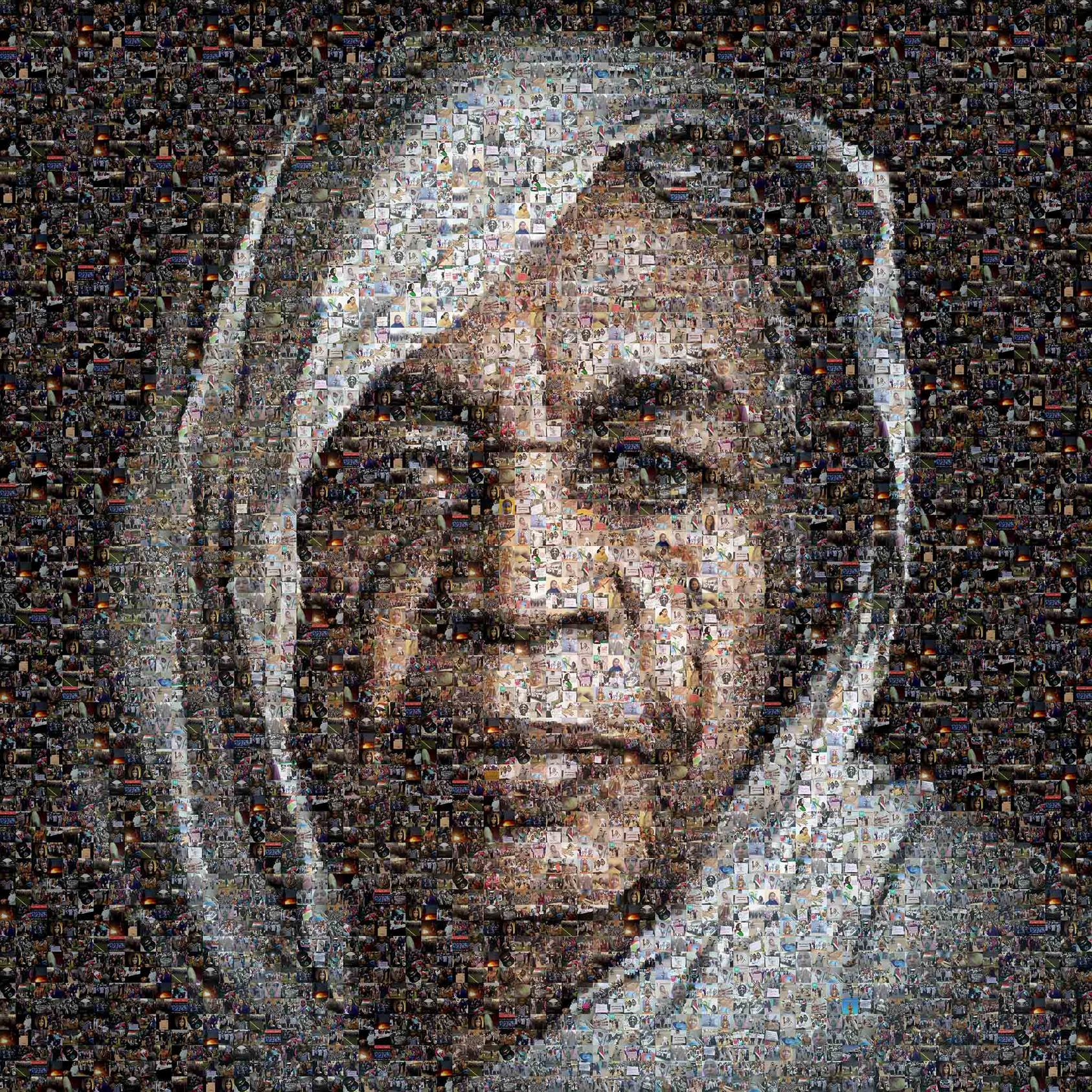
Revolution on Canvas: Sudan’s Unique Artistic Tradition
Mustafa Abushamma was not surprised that Sudanese artists were able to reach such a wide audience during the revolution, as Sudan is often recognized as an important influence in the development of modern art in Africa through the Khartoum School—Sudan’s modernist art movement founded in 1960. “Sudanese art is a mix of Arab and African, and this is very unique to Sudan,” said Abushamma. “The art coming out of Sudan is not like any art around the world … we see that in the colors, the motifs that we use, and it speaks to a lot of people.”
Abushamma founded his gallery 10 years ago to highlight a diverse slate of artists and to get more Sudanese art into Sudanese homes. He is pleased with the changes that he has seen, noting that increased appreciation for original art means that more artists are able to support themselves. And even amid a tenuous democratic transition, Mustafa is energized for the future when he speaks about the trajectory of young Sudanese artists. Describing the work of Darfuri artist Osman Gouma Ahmed, currently in his early 20s, Mustafa says, “Can you imagine what he will be able to do in 10 years?”
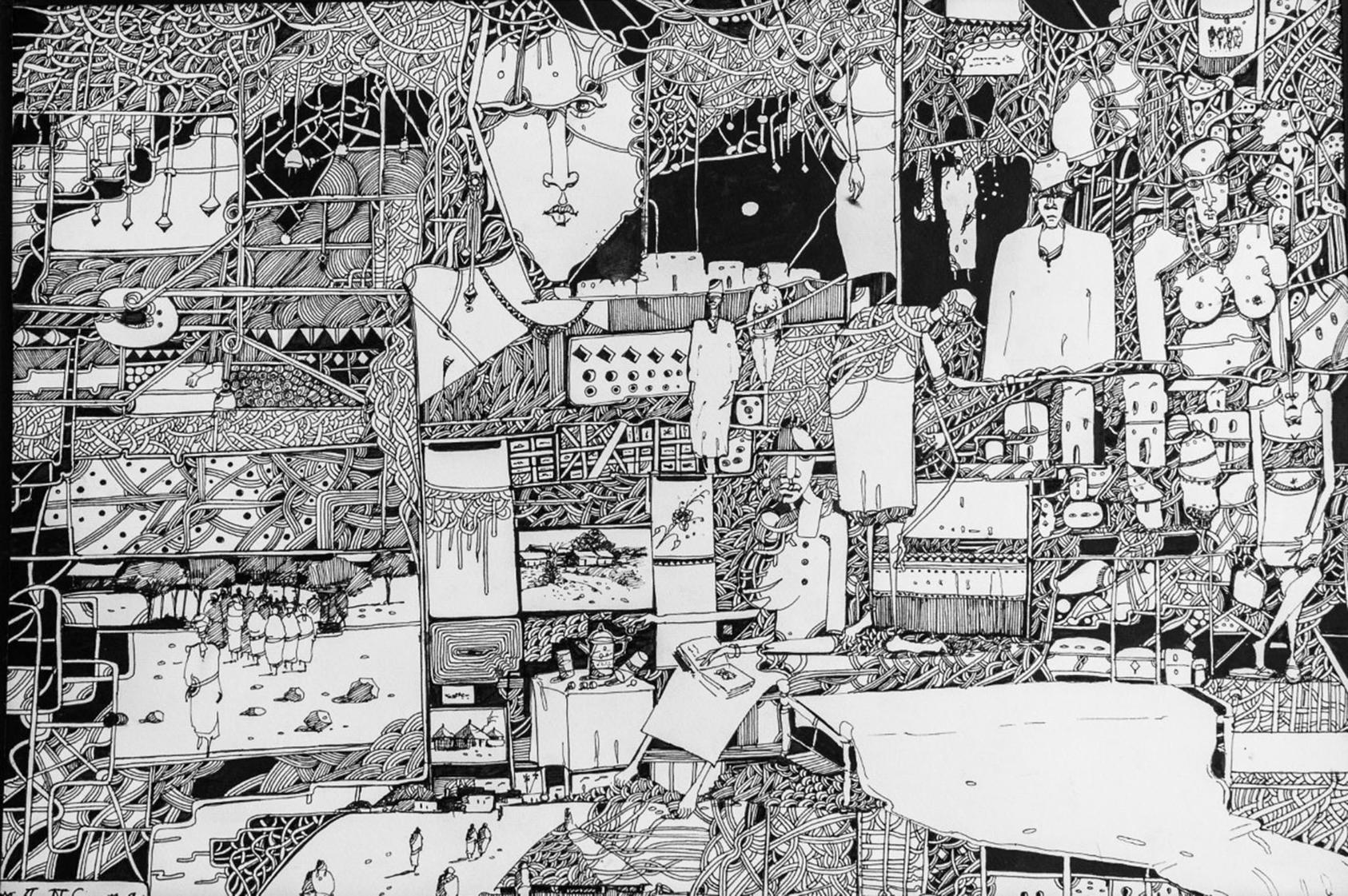
Hussein Merghani is a more seasoned artist who is also featured at Mojo Gallery. His watercolor of the Atbara Train—also known as the Freedom Train—captured one of the most iconic images of the revolution. Hundreds of protestors from Atbara, a city in Sudan’s north that saw some of the earliest protests in the revolution, commandeered a train in April 2019 to travel southward to Khartoum to join the sit-in at the military headquarters. As the train moved slowly along its 200-mile route, Sudanese cheered from alongside. The Atbara Train came to symbolize the broad support for the revolution from across the country. While the Atbara Train watercolor (featured at the top of the page) captures one of the joyous moments of the revolution, Hussein has also depicted the tense everyday moments in the months-long demonstrations, including in a watercolor of a young boy leading a protest with an empty water barrel.
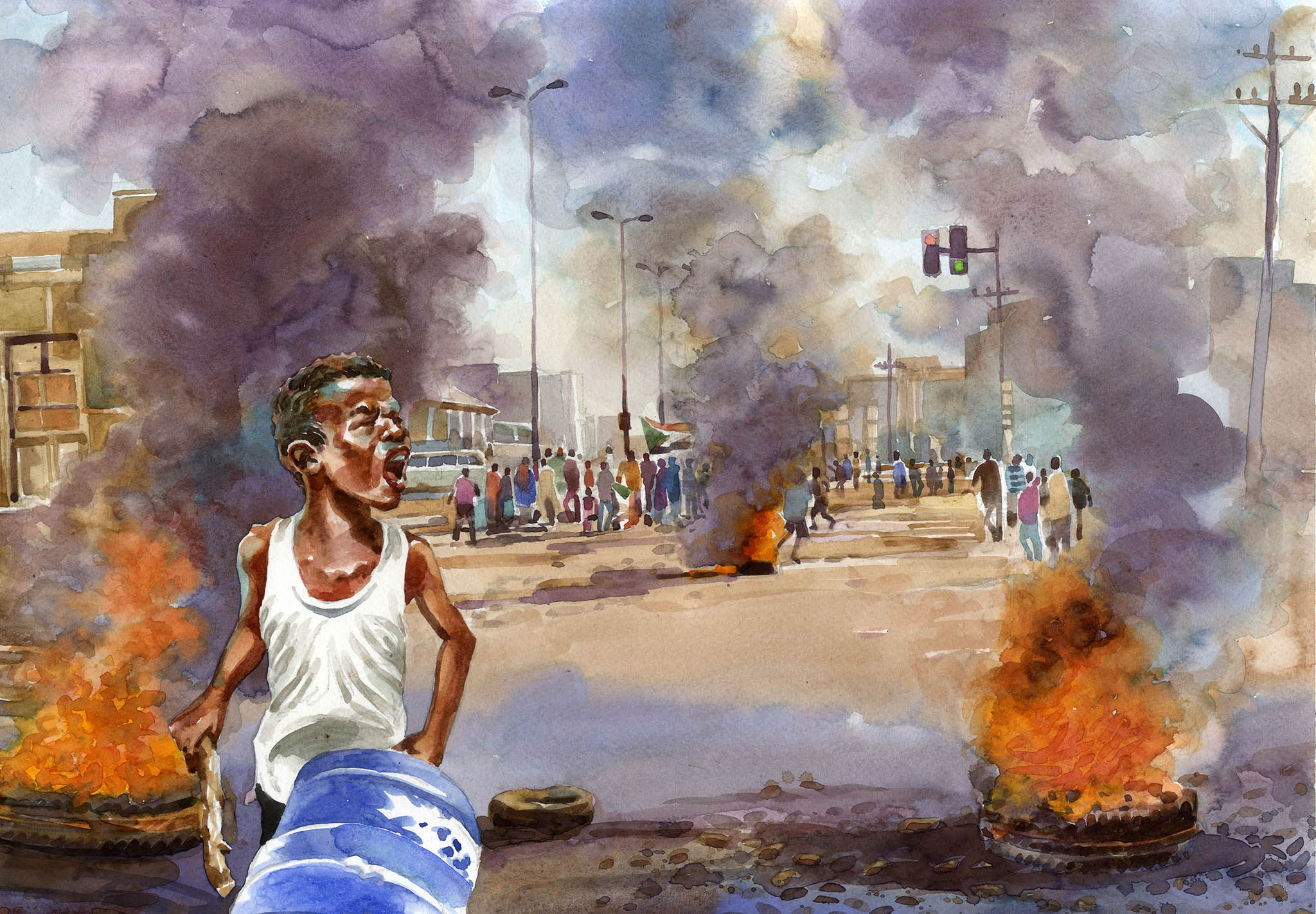
Art in the Transition
Hussein Merghani has used proceeds from his art to pay for continued mural painting around the site of the sit-in at Khartoum’s military headquarters. And he’s not alone—as Sudan shifts from revolution to transition, other artists are supporting social projects throughout the country.
Muralist Assil Diab has adapted her art to the COVID-19 reality, painting murals that encourage mask wearing—including one featuring a diverse group of Sudanese people wearing traditional dress and face masks. As she was painting the mural, she and her team took the opportunity to raise awareness of health precautions with passersby.
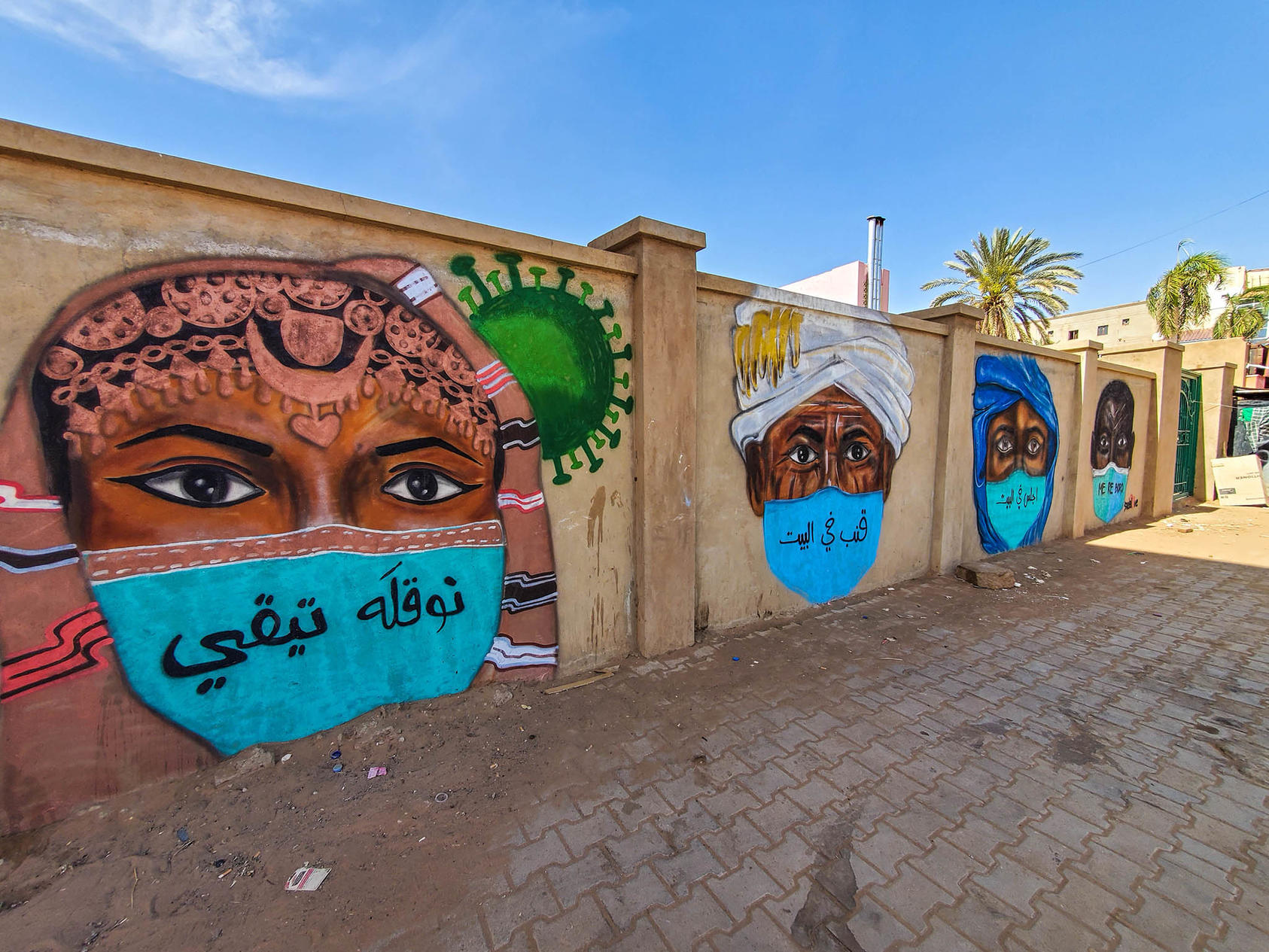
Publishing with the hashtag #Khartoon, internationally renowned cartoonist Khalid Albaih levels sharp-witted critiques of injustices around the world. In July, following the army’s statement that citizens publicly criticizing the military could be arrested, he published a widely shared cartoon of a crocodile in military fatigues with large tears rolling down its face. Khalid’s work has mobilized others to use art as a tool to advocate for change in Sudan. And Khalid does not limit his expression to art—he has also written widely, including on the need for further U.S. support to Sudan’s transition.
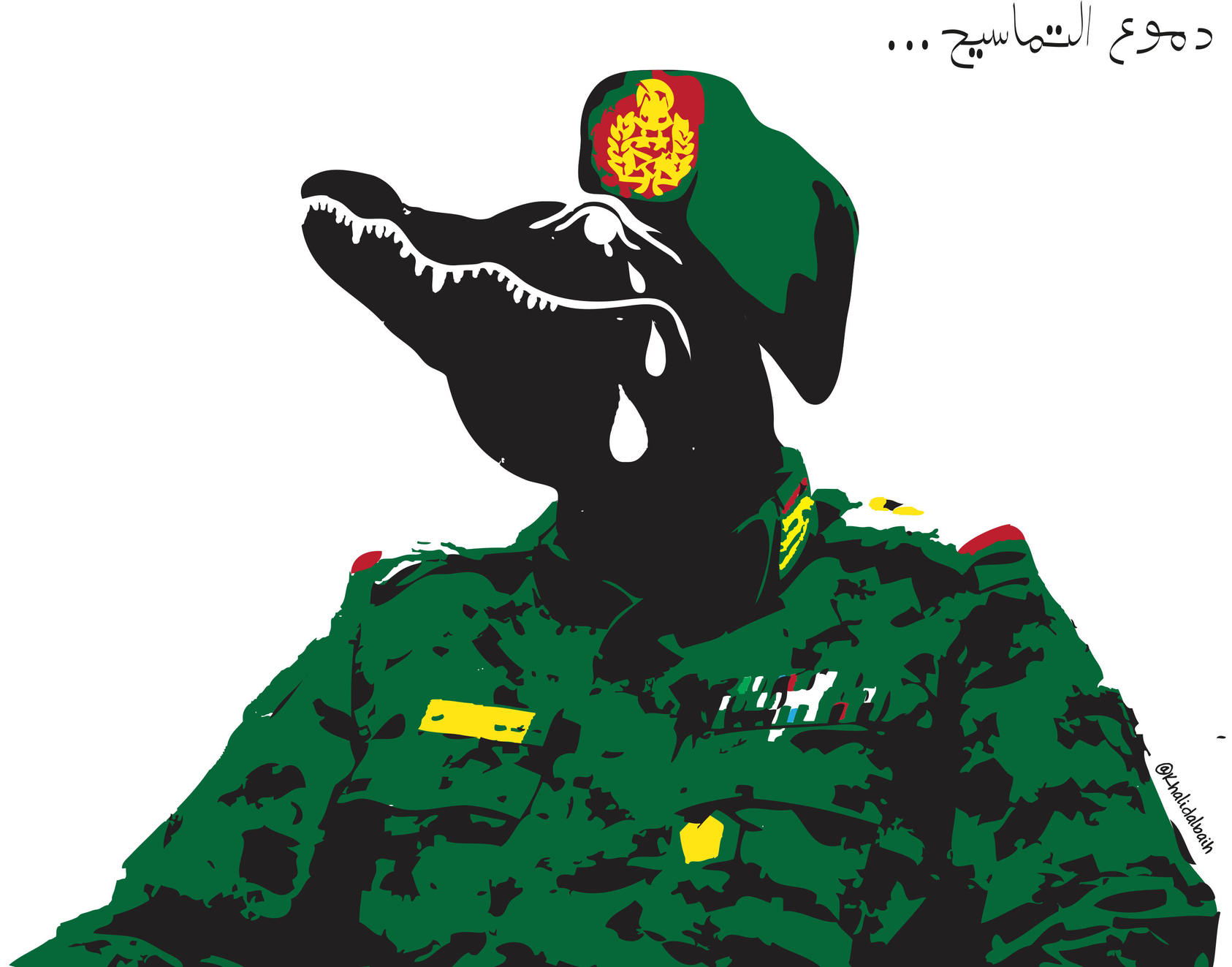
Sudan’s nonviolent revolution and the creativity that buoyed it are reasons for celebration. But the country faces a myriad of challenges during its transition, including a pandemic and a severe economic crisis that have led to renewed protests in the streets. Additionally, a prominent case where 11 Khartoum artists were jailed this past August has drawn broad condemnation, highlighting the need for legal and judicial reform during the transition to protect freedom of expression.
The work must continue, and there is still an important role for artists—in opening space for public conversations, expressing grievances and hopes, and helping to hold all bodies of the transitional government to account. And the transitional government can honor Sudan’s recent history by preserving revolutionary art for future generations and by nurturing the immense talent and creativity that helped to bring it to power.
https://www.usip.org/publications/2020/11/three-things-you-thought-you-knew-about-freedom-religion-or-belief
Three Things You Thought You Knew About Freedom of Religion or Belief
By Jason Klocek; Scott Bledsoe
An ever-growing amount of data on global religious restrictions challenges us to rethink best practices for promoting religious freedom.
Accounts of global religious restrictions and hostilities have, unfortunately, become a regular feature of today’s news cycle. India’s passage of the Citizenship Amendment Act, which uses religious identity as a criterion for citizenship, and its violent crackdown against protesters made headlines at the turn of year. The Chinese government’s detention of more than a million Uyghur Muslims, increased surveillance, and other religious regulations in Xinjiang continue to garner much attention. And, increasingly more concern has been given to the ongoing attacks on Christian communities in Nigeria. While these examples are, of course, worrying and must be addressed, a deeper dive into the data reveals that many of the assumptions we hold about the state of global religious freedom need further unpacking.
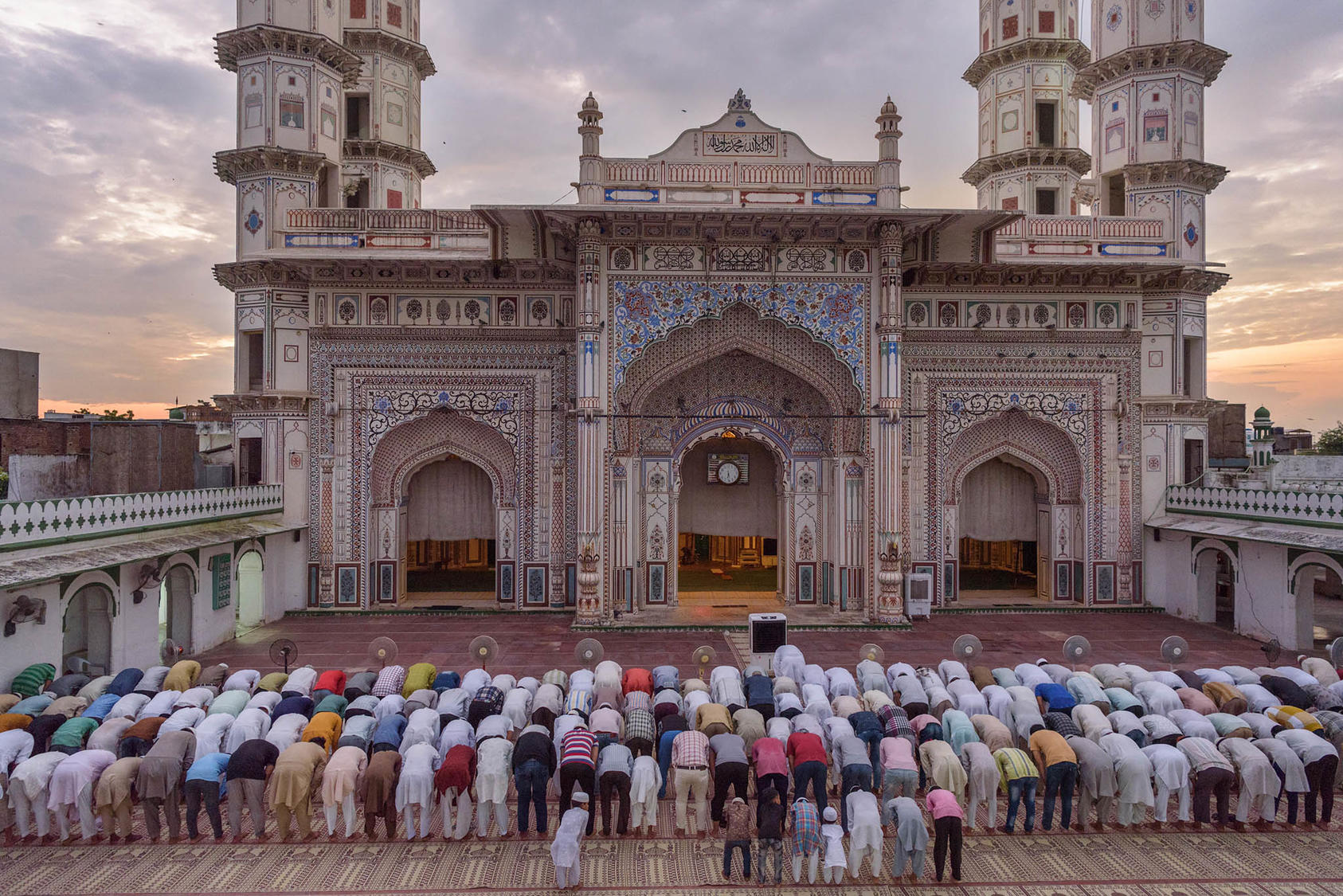
Next week Poland will convene the third Ministerial to Advance Freedom of Religion or Belief with such questions in mind. The virtual meeting will bring together government and civil society leaders from around the world with the goal of scaling up the international community’s efforts to protect and promote the right to freedom of religion or belief (FoRB). Informing much of that discussion will be the considerable amount of new data pointing to a steady decline in religious freedom around the globe, a pattern exacerbated further by the COVID-19 pandemic.
At USIP, we are also contributing to the conversation. As part of our “Closing the Gap” project, we recently compiled and analyzed a composite dataset consisting of diverse measures of religious freedom and relevant macrosocial factors for 176 states from 1990 to 2014. The former included three of the most prominent data sources on religious regulations and hostilities: the Pew Research Center’s Global Restrictions on Religion (Pew) data, the Religion and State (RAS) project, and the Varieties of Democracy (V-Dem) project. We were particularly interested in better understanding the relationship between religious freedom, political stability, and economic development.
Our findings both confirm and challenge conventional thinking, especially about the benefits of religious freedom. Most importantly, they underscore the need to consider the specific conditions under which FoRB impacts peace and development. The causes and consequences of religious restrictions are complex and may not operate the same in all environments.
Here are three things you may think you know about FoRB, but may be worth reevaluating.
1. FoRB is associated with democracy, but Western democracies do not necessarily have the highest levels of FoRB.
Today, the idea that FoRB and democracy go hand in hand is almost viewed as common sense. Our analysis generally confirms this relationship. We found a positive and significant correlation between religious freedom and a variety of democracy measures. Indeed, democracy stands out as the most consistent predictor of higher levels of FoRB in almost all of our models. Australia, Canada, Ireland, Mauritius, and New Zealand ranked particularly high. The story, however, does not end there.
While FoRB and democracy may frequently go together, they do not always do so—a point stressed in Dr. Jonathan Fox’s latest book on why governments discriminate against religious minorities. Drawing on his RAS dataset, Fox persuasively shows that democracies and even some non-democracies in Latin America, Asia, and sub-Saharan Africa engage in lower levels of religious regulation than many liberal Western democracies. Our analysis corroborates those findings.
Furthermore, FoRB and democracy do not always reinforce one another. Both the Pew and RAS datasets indicate that some of the largest increases in religious restrictions over the past half-decade have been in Western democracies, especially in Europe. France’s crackdown last month, including dozens of raids on Muslim aid groups, in the wake of a teacher beheading in a northern suburb of Paris and knife attack at a church in Nice suggest that this trend is not likely to wane, at least in the short term. Another reason for reservation is that rising religious restrictions in Europe are in line with other studies that note a worsening state of human rights in many democracies, even more so during the COVID-19 pandemic. In the end, democracy may contribute to, but does not necessarily guarantee, FoRB.
2. Religious restrictions can fuel conflict, and conflict can lead to religious repression.
Another oft-cited benefit of religious freedom is political stability and peace. The general idea is that religious discrimination, like other forms of state repression, can lead communities to take up arms in order to overcome their marginalization. This has been a concern raised, most recently, with respect to China’s crackdown against Uyghur Muslims, with many analysts warning that religious repression will eventually lead to a backlash in Xinjiang.
Our analysis supports this idea with two cautionary notes. One is that especially high levels of state repression often forestall armed rebellion. Take Vietnam, North Korea, Saudi Arabia, and Iran as examples. Each stands out as having some of the lowest levels of religious freedom in the world, but each also has a strong state apparatus that deters collective action and maintains stability, if not peace.
A second, equally important point, is that there is often a cycle of repression and violence. Repression can lead to conflict, but also conflict can lead to more religious regulation. For instance, intercommunal violence in Myanmar, especially between Buddhist and Rohingya communities, was followed by an uptick this past year in religious discrimination of Rohingya and other Muslims, Buddhists, Christians, and Hindus. In a similar pattern, Russia ramped up its regulation of faith communities once frontline rebel commanders in the North Caucasus began framing the conflict as a holy war and attracting an influx of foreign fighters. These examples also suggest that the type of conflict can matter. I have shown in other work with Dr. Peter Henne how religious rebellions, specifically, lead to more government regulation of faith communities.
3. FoRB does not guarantee economic growth.
A third purported benefit of religious freedom is economic growth, although it is often acknowledged that the link between the two is not necessarily direct. Rather, it is argued that religious restrictions and hostilities—and associated conflicts—can contribute to conditions that undercut growth, such as deterring investment or disrupting critical sectors of the economy. Much of the analysis backing these claims draws on the Pew data and focuses on conditions in a single year.
Our investigation does not yield similar support. Neither our time series nor our cross-sectional evaluation of specific years with other data sources—including a wide range of measures for economic development—offer robust evidence of a positive relationship between religious freedom and economic growth. If anything, we actually find a negative association between the two. This is perhaps less surprising when one considers that some of the sharpest declines in religious freedom in the past decade have been in upper middle- and high-income countries, including Western democracies as discussed above. It certainly calls for additional study.
In conclusion, our findings raise important questions about how to scale up the international community’s efforts to better protect and promote FoRB. Most importantly, they stress the need for more understanding of when and where FoRB is most likely to impact peace and development. There is no denying that millions around the world still face substantial constraints on their ability to adhere to and practice their faith in private or public or hold no faith at all. We hope our work will challenge policymakers and practitioners alike to take advantage of the full set of tools available for advancing FoRB.
Scott Bledsoe is a research assistant for the Religion and Inclusive Societies program at the U.S. Institute of Peace.
USIP Publication: What Ethiopia’s Brewing Conflict Means for the Country—and the Region
https://www.usip.org/publications/2020/11/what-ethiopias-brewing-conflict-means-country-and-region
Violent conflict between the federal government of Ethiopia and the federal state of Tigray, in the country’s north, began November 4 and quickly escalated. USIP’s Aly Verjee and Susan Stigant discuss the crisis and identify what could be done to avoid further violent conflict in east Africa’s most populous country.
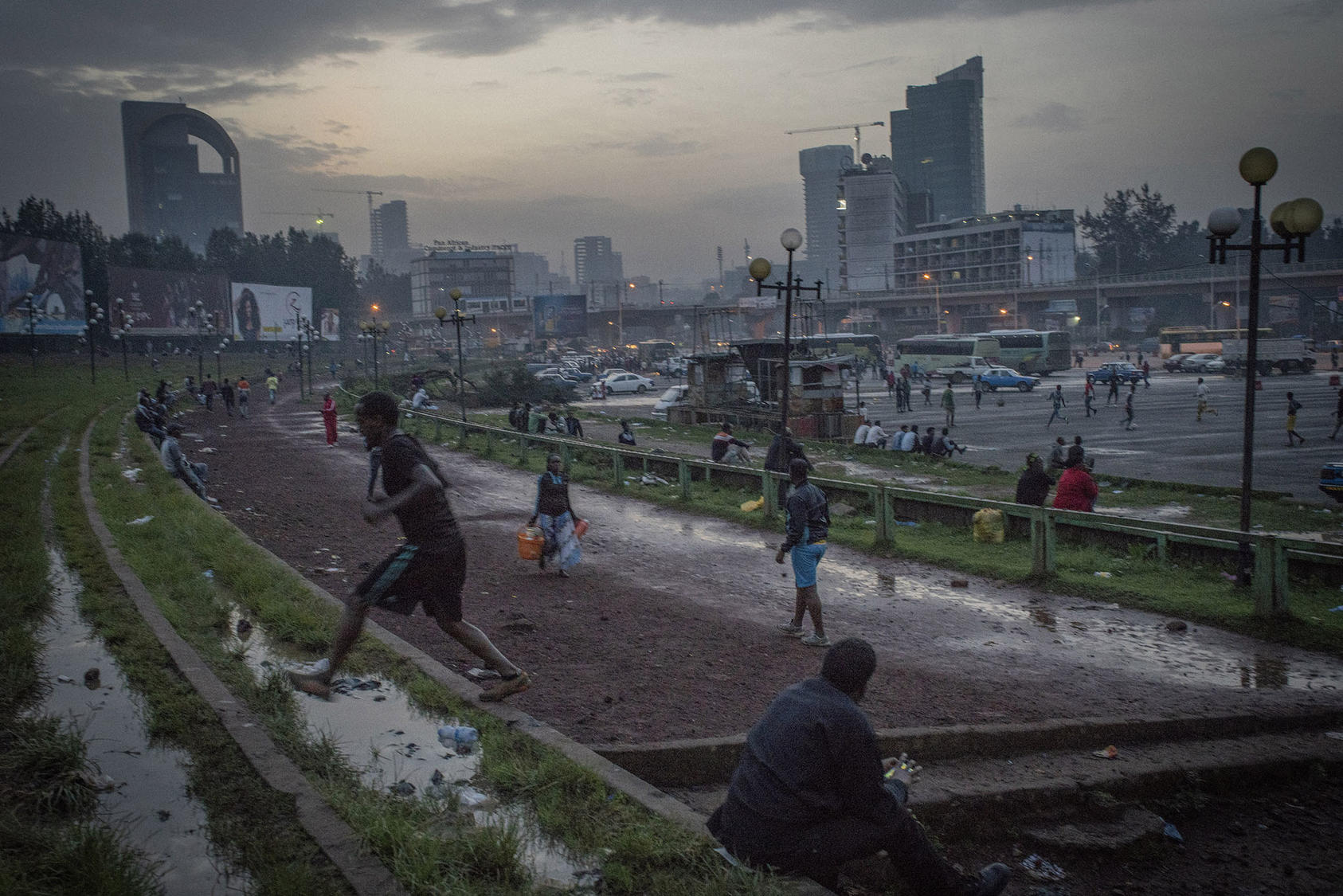
Unfortunately, violence is not new to Ethiopia; already, there are over 1.4 million conflict-affected internally displaced persons in the country. What is the broader significance of this latest violence between the federal government and the Tigray region?
Stigant: The rapidity of the escalation of violence between Tigray and Addis Ababa is concerning in itself, given the stakes for Ethiopia’s peace and stability. This conflict has the potential to quickly become more polarized and increase violence throughout Ethiopian society. Already, the Tigray region has called for the full mobilization of all citizens to fight. The federal government, led by Prime Minister Abiy Ahmed, has also used uncompromising language to justify his government’s actions. As the allegations and incidents mount—including possible war crimes—and the number of people affected increases, it will become much harder to find a peaceful solution.
At the same time, solely focusing on what is going on today in Tigray risks obscuring broader concerns about violence, democratic backsliding, and repression elsewhere in the country. As a horrific example of the type of violence in Ethiopia that has become all too common, on November 1, ethnically targeted killings left at least 54 people dead in a schoolyard in the Wollega zone of Oromia state. Throughout western Ethiopia, communal violence has only increased since 2018. In southern Ethiopia, tensions remain high, as the consequences of the model of ethnic federalism continue to unfold.
Verjee: As I warned in April 2019, tensions between the regions have the potential to overwhelm the political management capacity of the center. The conflict in Tigray has already pulled in forces from the neighboring Amhara Regional State to fight the Tigrayans. The leadership of the Somali Regional State has also taken the side of the federal government in the dispute. In the broader context, it does not really matter who is responsible for starting the violence; all Ethiopians, no matter their ethnicity, have to find a way to live side-by-side, which will not be accomplished by jailing or killing the political and military elite of Tigray. The ruling party of Tigray, the Tigrayan People’s Liberation Front (TPLF), which once led the ruling party coalition that preceded the Abiy government, are no angels. But for the federal government to risk throwing the whole country into a protracted civil conflict—with significant cross-border consequences—is also highly unfortunate.
Already, a humanitarian crisis is in the making. More than 11,000 refugees have already crossed the border with Sudan, with thousands more almost certain to follow. Drawing in Eritrea and Sudan into the conflict may easily bring in other regional and extra-regional powers, leaving the Horn of Africa in a complicated, messy crisis from which it may take many years to recover, at a cost of thousands of lives. As the USIP Red Sea Senior Study Group recently warned, “Intrastate or interstate conflict would be catastrophic for Ethiopia’s people and for the region and would pose a direct threat to international peace and security.”
The dispute between Tigray and the federal government has been festering for some time. Could violence be avoided?
Stigant: The federal government has characterized its action as a rule of law operation to uphold the constitution, and that it would act with “utmost care for the overall wellbeing, safety and security of our citizens.” The federal government has described the September 2020 elections held by the Tigray region as illegitimate and has objected to equating the federal government to the TPLF. While there are more than two sides to every story, there is little doubt that relations were strained with Tigray. That said, the paramount constitutional right of any citizen is the right to life. Before resorting to military action and the attendant deaths of Ethiopian citizens, every other possibility needed to be exhausted, even if the Tigray authorities were being uncooperative. More pragmatically, the use of force rarely works to sustain a political settlement, as the history of Ethiopia has shown on numerous occasions.
As the cornerstone of his rule, Prime Minister Abiy set out a philosophy of medemer, or coming together, to overcome the divisions of the past. Less than a year ago, in accepting the Nobel Peace Prize, Abiy mentioned the word love seven times, and the words forgiveness and reconciliation four times each. Ethiopia does not need Abiy to love Tigray, nor vice versa; but forgiveness and reconciliation cannot occur if belligerent parties do not show restraint.
Verjee: The federal government has already suspended fiscal transfers to Tigray and cut off communications and cross-border trade. Even if the allegation that the TPLF posed an imminent threat by its purported seizure of weapons and a military base is entirely accurate, a proportionate, limited response was the most that could be justified. Although the federal government has said that its operations will be time limited, Abiy has also said that he will not rest until the “the criminal junta is disarmed, legitimate administration in the region restored, and fugitives apprehended and brought to justice,” which are objectives that could take months, if not years, to achieve. Although the warning signs have been there for some time, a protracted violent conflict is still not inevitable, but it will require both sides to choose another path.
Abiy should also consider that his own position as head of the government comes in the context of an ongoing debate about the future of the constitutional order of Ethiopia. Were it not for COVID-19, Ethiopia should have held elections this year, in which Abiy would have had the opportunity to obtain a democratic mandate. Abiy may be prime minister and enjoy the powers of that office but should consider his administration bound by norms that limit the actions of an unelected official.
To date, the federal government has rejected mediation of this crisis. Going forward, what role should national and international actors play to try and de-escalate the situation?
Stigant: For years, Ethiopia has been at the heart of establishing regional and continental mechanisms for addressing violent conflict. These include the Conflict Early Warning and Response Mechanism of the regional intergovernmental organization IGAD, which Ethiopia chaired for years, and the Peace and Security Council and the Panel of the Wise of the African Union (AU). As the AU’s host nation, there is arguably a special responsibility on Ethiopia to call on these indigenous African institutions not as an intrusion on sovereignty, but to model exemplary behavior for all African states.
Domestically, there have been multiple calls for a national dialogue to forge a political agreement regarding the conduct of elections and then on the constitutional order following the elections. As violence escalates in the country, it becomes both more urgent and more challenging to move a dialogue process forward. While the federal government has already announced such an effort, any initiative will need to be revisited in light of the changing circumstances. Ultimately, the credibility of any dialogue will be judged on the extent to which it includes key groups, reaches agreement on preparatory steps and confidence-building measures, and demonstrates that people can have genuine, safe, and frank conversations.
Verjee: The United States, the European Union, and the United Kingdom, all leading humanitarian donors, should urgently articulate the acute priority of preserving and enhancing humanitarian access to Tigray on the ground, to internally displaced persons moving to other states of Ethiopia, and to the refugees in Sudan. There is no acceptable reason for impeding this kind of access.
More broadly, as USIP’s Payton Knopf has written, international inertia on Ethiopia cannot be justified by imperfect or incomplete information. While American leverage on Ethiopia has been damaged by President Trump’s remarks on the Grand Ethiopian Renaissance Dam, Ethiopia remains a vital strategic partner for the United States in matters of regional security, counterterrorism, migration, and peacekeeping. China is also massively invested in Ethiopia, in many deals that were reached in the days of the rule of the TPLF. Therefore, the United States, China, and others have a mutual interest in seeing a quick end to hostilities, creating the space for other forms of dialogue and discussion. While a formal international mediation process may not be necessary, honest international brokers should urgently convey to both sides, in unequivocal terms, their expectation and hope that hostilities should be halted without further delay.
11/13/2020 News & Commentary - Korea
News & commentary by Dave Maxwell. Edited and published by Duncan Moore.
1. N.K. leader out of public eye for 23rd straight day
2. North Korea thinks that smoking can spread coronavirus
3. Shining a light on North Korea’s illicit shipping and sanctions evasion practices
4. Interview: ‘North Korean refugees in China are not protected by anyone,’ says refugee-turned-lawmaker in South
5. Ministry renews calls for N. Korea to act in 'discreet, wise and flexible' manner after Biden's election
6. N. Korea's propaganda outlet claims country developed satellite-based maritime data system
7. South Korea's hyper-tube train hits major milestone with 621 MPH
8. Sketching out North Korea's possible Joe Biden strategy
9. Korea to sign China-led mega FTA
10. N. Korea continues crackdown on use of Chinese-made mobile phones
11. North Koreans' Twitter accounts 'rare propaganda move'?
12. S. Korea should send strong message to N. Korea not to make provocations: ex-U.N. chief
13. New virus cases spike to over 2-month high, tougher restrictions under review
14. North Korean government continues to strengthen market control
15. North Korea dubs global atomic watchdog a 'dancing marionette'
16. New evidence suggests North Korea has a naval marine mammal program
17. Chinese President Xi Jinping to visit South Korea in next few weeks, Yonhap says
1. N.K. leader out of public eye for 23rd straight day
Yonhap News Agency · 이원주 · November 12, 2020
The Kim Jong-Un watch continues. I am sure he loves seeing these reports. Miss me yet?
2. North Korea thinks that smoking can spread coronavirus
National Interest · Stephen Silver · November 12, 2020
This is what happens when you use "Juche-based science."
3. Shining a light on North Korea’s illicit shipping and sanctions evasion practices
Maritime Fairtrade · Kok Leong Lee · November 6, 2020
Excellent discussion with my colleague, Mathew Ha.
4. Interview: ‘North Korean refugees in China are not protected by anyone,’ says refugee-turned-lawmaker in South
Radio Free Asia · November 11, 2020
In addition to being a moral imperative, human rights is a national security issue. I hope Ji Seong-ho can use his office to influence the Moon administration to take north Korean human rights seriously.
5. Ministry renews calls for N. Korea to act in 'discreet, wise and flexible' manner after Biden's election
Yonhap News Agency · 고병준 · November 13, 2020
Discreet, wise, and flexible. Words Kim Jong-un would never understand. Yes, I say that with some sarcasm. But on a serious note, these are ideas that express the assumptions about the regime upon which the Moon administration bases its policies and strategies. The administration must reassess its assumptions and Moon and Biden must align their assumptions based on an objective understanding of the nature of the Kim family regime and its objectives and strategies.
6. N. Korea's propaganda outlet claims country developed satellite-based maritime data system
Yonhap News Agency · 고병준 · November 12, 2020
Hmmm...
7. South Korea's Hyper-Tube Train Hits Major Milestone with 621 MPH
Interesting Engineering · Fabienne Lang · November 12, 2020
Very cool. Good work, Korea.
8. Sketching Out North Korea’s Possible Joe Biden Strategy
National Interest · Jason Bartlett · November 12, 2020
I am going to beat this horse: deterrence, defense, denuclearization, the Korea question (unification), using a superior form of political warfare based on a rock-solid ROK/US alliance, and realistic assumptions of the nature of the Kim family regime and its strategy and objectives.
9. Korea to sign China-led mega FTA
Chosun Ilbo · Ahn Jun-yong · November 13, 2020
Will South Korea continue to be an economic hostage to China??? We really hurt ourselves by pulling out of TPP. It is probably too late now, but imagine where we would be if we had led the way on TPP four years ago. I believe we would have been in a much better position to compete economically with China.
10. N. Korea continues crackdown on use of Chinese-made mobile phones
Daily NK · Kang Mi Jin · November 13, 2020
Yes, such calls must stop. The regime cannot have the Korean people using communications means that will rapidly transmit information, which includes the especially "damaging" information about the outside world.
11. North Koreans’ Twitter accounts ‘rare propaganda move’?
Korea Times · Yonhap · November 13, 2020
I would think the regime would rather embrace Parlor rather than Twitter (tongue in cheek). But on a serious note, this is something we should be observing and figuring out how to exploit.
The Uriminzokkiri twitter in English only posts links to its propaganda articles. It is pretty lame and boring.
12. S. Korea should send strong message to N. Korea not to make provocations: ex-U.N. chief
Yonhap News Agency · 최수향 · November 13, 2020
I hope Ban Ki-moon runs for President in South Korea.
13. New virus cases spike to over 2-month high, tougher restrictions under review
Yonhap News Agency · 김은정 · November 13, 2020
It is all relative. This looks bad in South Korea, but it is nothing compared to what is happening in the US. It seems like the virus may be getting stronger around the world. Or people just do not have the discipline to sustain implementation the right countermeasures.
14. North Korean government continues to strengthen market control
North Korea Economy Watch · Benjamin Katzeff Silberstein · November 13, 2020
This is what it is all about for the regime. Control. Maximum control. Control over every aspect of North Korea.
15. North Korea dubs global atomic watchdog a 'dancing marionette'
Reuters · Michelle Nichols · November 11, 2020
I always admire the rhetoric of the North's Propaganda and Agitation Department.
16. New evidence suggests North Korea has a naval marine mammal program
USNI · H I Sutton · November 12, 2020
I wonder if the animal rights groups will go to North Korea to protest this program (note: sarcasm).
17. Chinese President Xi Jinping to visit South Korea in next few weeks, Yonhap says
South China Morning Post · Eduardo Baptista · November 12, 2020
I have not seen any other reporting on this.
"Riches are apt to betray a man into arrogance."
-Joseph Addison
"The truest characters of ignorance are vanity, and pride, and arrogance."
- Samuel Butler
“There are many men of principle in both parties in America, but there is no party of principle."
- Alexis de Tocqueville
An "Oh So Social"Conversation Series courtesy of the OSS Society
Five separate conversations took place in October 2020
https://www.osssociety.org/oh_so_social.html (Click on the Individual Images at the link to watch the videos)
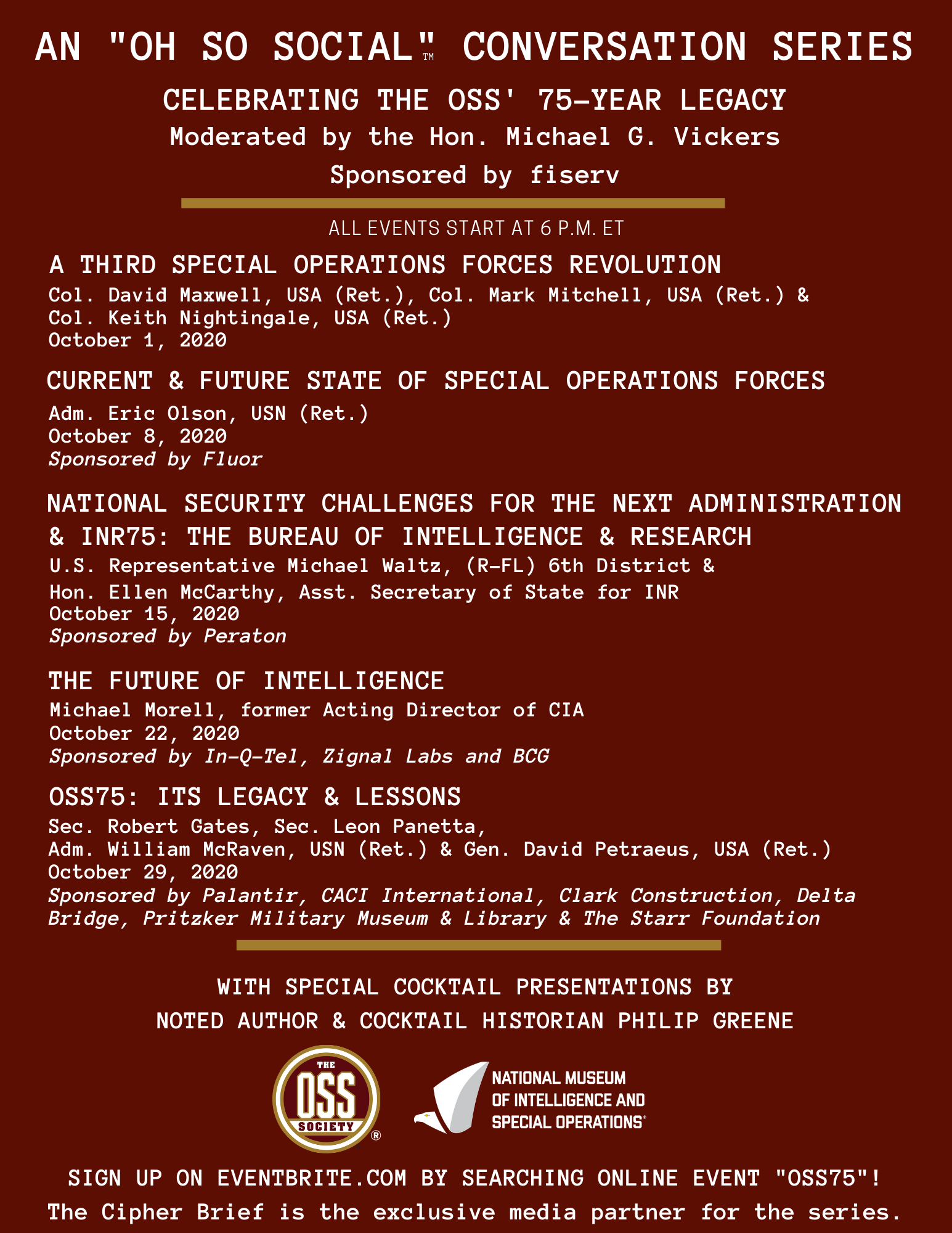
11/11/2020 News & Commentary - National Security
News and Commentary by Dave Maxwell. Edited and Published by Riley Murray.
1. Biden landing team for Pentagon announced
2. Ponder the Rewards of Military Service
3. The Worst Day of the Pandemic Since May
4. Hong Kong pro-democracy lawmakers resign after China ruling
5. Taiwan Issues Rare Confirmation That U.S. Special Operators Are Training On The Island
6. U.S. Tried a More Aggressive Cyberstrategy, and the Feared Attacks Never Came
7. Biden will place Asia back at the centre of foreign policy - but will his old-school diplomacy still work?
8. K-pop band Blackpink prompt anger in China by holding baby panda without gloves
9. Philippines Extends Stay Order on Military Deal With U.S.
10. US 'disappointed' as Cambodia razes another military facility
11. US human rights ripped by Russia, China, North Korea during UN panel
12. American Military History is Wrong
13. 2020 Is An Election Security Success Story (So Far)
14. Remembering When the Memories Are No Longer Our Own
15. Special forces veteran and Stanford scholar applies data and scholarship to conflict
16. Department of Veterans Affairs Approves Green Beret Foundation Accreditation
17. Pentagon refutes reports that Marine Raiders are training forces on Taiwan
1. Biden landing team for Pentagon announced
Defense News · by Aaron Mehta · November 10, 2020
Here is the link to all the transition/landing teams for all the agencies: https://buildbackbetter.com/the-transition/agency-review-teams/
Personnel is policy or policy is personnel. I think you can make some assessments on the future of certain policies based on the personnel who will be recommending the personnel.
2. Ponder the Rewards of Military Service
WSJ · by H.R. McMaster
3. The Worst Day of the Pandemic Since May
defenseone.com · by Alexis C. Madrigal and Erin Kissane
Wow. What are we going to do? We cannot wait for a vaccine.
4. Hong Kong pro-democracy lawmakers resign after China ruling
This says it all. How would you like to live in a country that makes these kinds of loyalty demands: "Either way, now the city government has been empowered to remove any pro-democracy politician who is seen to have acted with insufficient loyalty to the motherland in the future."
5. Taiwan Issues Rare Confirmation That U.S. Special Operators Are Training On The Island
thedrive.com · by Thomas Newdick · November 10, 2020
I have not yet seen any significant propaganda response from the CCP.
6. U.S. Tried a More Aggressive Cyberstrategy, and the Feared Attacks Never Came
The New York Times · by David E. Sanger · November 9, 2020
Good work by CYBERCOM.
7. Biden will place Asia back at the centre of foreign policy - but will his old-school diplomacy still work?
theconversation.com · by Nick Bisley
Of course, the title question is the $64,000 one!
8. K-pop band Blackpink prompt anger in China by holding baby panda without gloves
The Guardian · by Justin McCurry · November 11, 2020
The battlefield of soft power.
9. Philippines Extends Stay Order on Military Deal With U.S.
Bloomberg · by Andreo Calonzo · November 11, 2020
10. US 'disappointed' as Cambodia razes another military facility
news.yahoo.com · November 10, 2020
It seems for all intents and purposes Cambodia is being absorbed by China.
11. US human rights ripped by Russia, China, North Korea during UN panel
New York Post · by Emily Jacobs and Aaron Feis · November 10, 2020
Admit nothing, deny everything, and make counter accusations. We have ceded our place on the battlefield of international organizations as we no longer desire to compete there.
12. American Military History is Wrong
mwi.usma.edu · by Glenn M. Harned · November 11, 2020
Truth in lending. I was a team leader and then battalion S3 for COL Harned.
This is a provocative thesis: "The "So what?" is that our study of American military history has failed our profession and our nation. American military history as taught in professional military education institutions (and more generally in our public education system) is wrong and fosters a strategic culture inconsistent with strategic reality."
Conclusion: "Outcomes-based strategies will be critical to reversing the trend of US armed forces winning every battle, prevailing in every campaign, and losing every war it has fought since 1955. The first step: fostering a more accurate understanding of American military history, especially in professional military education."
13. 2020 Is An Election Security Success Story (So Far)
lawfareblog.com · by Scott R. Anderson, Susan Hennessey, Rohini Kurup, David Priess, Jacob Schulz · November 7, 2020
14. Remembering When the Memories Are No Longer Our Own
warontherocks.com · by Peter Lucier · November 11, 2020
15. Special forces veteran and Stanford scholar applies data and scholarship to conflict
news.stanford.edu · by Stanford University · November 10, 2020
Excellent story about a great American and veteran who continues to serve and contribute.
16. Department of Veterans Affairs Approves Green Beret Foundation Accreditation
greenberetfoundation.org · November 11, 2020
The Green Beret Foundation does great work for our Green Berets and their families.
17. Pentagon refutes reports that Marine Raiders are training forces on Taiwan
Stars and Stripes – by Seth Robson – 10 November 2020
I did not see this one coming. This will be interesting to run to ground and learn the facts.
"The willingness with which our young people are likely to serve in any war, no matter how justified, shall be directly proportional to how they perceive the Veterans of earlier wars were treated and appreciated by their nation."
- President George Washington
"The brave men, living and dead, who struggled here, have consecrated it, far above our poor power to add or detract. The world will little note, nor long remember what we say here, but it can never forget what they did here."
- Abraham Lincoln
"We remember those who were called upon to give all a person can give, and we remember those who were prepared to make that sacrifice if it were demanded of them in the line of duty, though it never was. Most of all, we remember the devotion and gallantry with which all of them ennobled their nation as they became champions of a noble cause."
- Ronald Reagan
11/11/2020 News & Commentary - Korea
News and Commentary by Dave Maxwell. Edited and Published by Riley Murray.
1. N. Korea estimated to have up to 60 nuclear warheads: U.S. think tank
2. N. Korea moves to further strengthen offensive capabilities on Korean border
3. Moon to hold phone talks with Biden soon: Cheong Wa Dae official
4. South Korean spy chief proposes Olympic summit with US, North Korea, Japan: Report
5. A Hypothetical Letter From North Korea's Chairman Kim Jong Un to US President-Elect Joseph Biden
6. Kim 'to test Biden with barrage of nuke missile tests around inauguration'
7. OPCON Transfer and its Potential Impact on the UNC and the NNSC
8. Can Moon's U.S. Diplomacy Get Any Worse?
9. South Korea appealed for Biden's 'summit-level' interests in North Korea talks
10. North Korea Is Emphasizing Potato Production. That Might Be a Bad Sign
11. Moon meets veteran diplomats for discussions on U.S. presidential election outcome
12. Another Korean-American Woman Wins U.S. House Seat
13. Gov't needs experts on alliance and N. Korean nuclear power
14. Chilly North Koreans Grumble as Authorities Ban Firewood Trade Ahead of Winter
15. How Populist Tactics Solidify the Legitimacy of North Korea's Supreme Leader
16. Military to improve border security system following N. Korean's unhindered crossing
1. N. Korea estimated to have up to 60 nuclear warheads: U.S. think tank
en.yna.co.kr · by 이원주 · November 11, 2020
I have sent out the NDU Strategic Assessments 2020. Here is the link to the 368 page report which as I have said is a very useful reference. https://ndupress.ndu.edu/Portals/68/Documents/Books/SA2020/Strategic-Assessment-2020.pdf?ver=-NTckVdG56-CfFYJ73PTgg%3d%3d
Here is the paragraph on page 225 the Yonhap article below is referencing.
Through the development of weapons of mass destruction, use of chemical weapons, and aggressive posturing of its conventional forces, the DPRK threatens regional stability and global norms. North Korea is estimated to have somewhere between 15 and 60 nuclear warheads, as well as approximately 650 ballistic missiles that could threaten cities in South Korea, Japan, and eastern China.44 It has also tested intercontinental ballistic missiles that could be capable of striking the United States.45 At the same time, North Korea continues to pose a conventional threat to South Korea and Japan. The People's Army, an estimated 1.2 million in strength, is overwhelmingly forward-deployed toward the Demilitarized Zone in an offensive posture.46 Kim has also pursued more advanced conventional capabilities, including more precise artillery and ballistic missile capabilities as well as UAVs.47 In this environment, North Korea's nuclear arsenal provides Pyongyang with the potential for nuclear blackmail, allowing it to engage in lower level conventional provocations and, at the same time, affect South Korean and U.S. decisions on kinetic responses or induce economic concessions.
2. N. Korea moves to further strengthen offensive capabilities on Korean border
dailynk.com – by Jeong Tae Joo - November 11, 2020
I do not really depend on Daily NK for military analysis (expect when it confirms my biases). But this is why I repeatedly beat the drum that the ROK/US alliance is postured for deterrence and defense while the 4th largest army in the world with 70% of its forces deployed between the DMZ and Pyongyang is postured for offensive operations. It is not postured for the defense. Its military posture supports the assessment that the Kim family regime seeks to dominate the Korean peninsula and unify under the rule of the Guerrilla Dynasty and Gulag State. We should not be swayed by the regime's rhetoric that it is developing deterrent capabilities. The October 10th military parade showed off its offensive capabilities.
So this article confirms my biased assessments.
3. Moon to hold phone talks with Biden soon: Cheong Wa Dae official
en.yna.co.kr · by 장동우 · November 11, 2020
My recommendation to President-elect Biden is to ask President Moon to undertake a reassessment, reexamination, and re-evaluation of the fundamental strategic assumptions about Kim Jong-un and the nature, strategy, and objectives of the Kim family regime. It is imperative that South Korea and the US develop combined policy and strategy based on a shared understanding about the basic strategic assumptions about north Korea. Alignment on the assumptions can drive effective policy and strategy. We have to deal with north Korea and the regime as it really is and not as we wish it would be. I recommend President-elect Biden ask President Moon to have the MOFA- State strategy working group conduct a combined policy and strategy review and develop a combined and unified way forward that will support, protect, and advance ROK/US alliance national interests.
Of course, if I were advising President Moon I would recommend he pre-empt the President-elect with an offer to conduct a combined strategic review and that he would pledge to objectively reassess his strategic assumptions.
While there are a number of critical alliance issues: OPCON transition, SMA stalemate, Support to THAAD, access to training areas for US forces, strategic flexibility for US forces, China relations, Japan relations, Quad and Quad plus, and deterrence, defense, denuclearization and unification. If we have sufficient alignment on the foundational assumptions about the Kim family regime our policies and strategies can align, and all the outstanding issues can fall into place with proper resolution.
4. South Korean spy chief proposes Olympic summit with US, North Korea, Japan: Report
I guess the 2018 Olympics were so successful for inter-Korean engagement they want to reprise it. But looking at this from north Korea's perspective a Quad summit would appear to the three against one (though the regime might find it useful as an opportunity to drive a wedge among all three "allies").
5. A Hypothetical Letter From North Korea's Chairman Kim Jong Un to US President-Elect Joseph Biden
38north.org · by Kenneth B. Dekleva M.D. · November 10, 2020
We have to deal with Kim Jong-un as he really is and not as we would wish he would be. I wish this would be the letter Kim would send (with sincerity). But even if he did send this type letter it would actually (and unfortunately) be part of his political warfare strategy it would actually be laying the groundwork for future blackmail diplomacy. Please accept my apologies for my cynicism.
6. Kim 'to test Biden with barrage of nuke missile tests around inauguration'
The Sun · by Jon Lockett · November 10, 2020
We shall see. There certainly has been enough speculation about this so if it happens it should be no surprise.
7. OPCON Transfer and its Potential Impact on the UNC and the NNSC
https://www.youtube.com/watch?v=f4T-6bDa-1U&feature=emb_logo
Shameless self-promotion. However, I can say this is an important discussion on the OPCON transition process. LTG Chun in Bum because with an explanation of President Moon's position that has never been publicly articulated. This is very important, and it needs to be emphasized. General Brooks gives one of the clearest articulations of the bilateral command structures and how it works - for both the ROK and US.
8. Can Moon's U.S. Diplomacy Get Any Worse?
Strong critique in the title and it gets worse from there.
9. South Korea appealed for Biden's 'summit-level' interests in North Korea talks
Reuters · by Hyonhee Shin · November 11, 2020
I fear the message is the Moon administration wants to double down on is peace at any cost. I do not think any of us can afford such a cost because it will be paid in blood and treasure given the nature of the Kim family regime and its objectives.
10. North Korea Is Emphasizing Potato Production. That Might Be a Bad Sign
The National Interest · by Stephen Silver · November 10, 2020
Someone mentioned on twitter that Kim Jong-un likes potato chips.
But seriously will this be like the previous campaign to raise rabbits to solve the food shortages?
I am thinking someone will want to drop in the old child's toy from the 1960s - Mr. Potato Head. - what a cruel thought.
Excerpt: "North Korea is said to have a propaganda song called "Potato Pride" which, according to its page at AllAroundthisworld.com, is "a North Korean propaganda tune in which the elder of the village receives his government ration of potatoes and shares it with his fellow villagers."
11. Moon meets veteran diplomats for discussions on U.S. presidential election outcome
en.yna.co.kr · by 황장진 · November 11, 2020
I am glad to see former Ambassador Ahn is getting an audience.
12. Another Korean-American Woman Wins U.S. House Seat
The Koreans are proud of Korean-Americans getting elected. Two Democrats and one Republican.
13. Gov't needs experts on alliance and N. Korean nuclear power
More critical commentary about the Moon Administration.
Conclusion: "The transition from Trump to Biden is not just a change of government, but a radical shift of international orders. South Korea would have to overhaul the current "secret room" diplomacy team that only focuses on the inter-Korean relations and restore the diplomacy line for the U.S. and North Korean nuclear power. Renewing the South Korea-U.S. relationship would be difficult without a drastic reshuffle of staff members."
14. Chilly North Koreans Grumble as Authorities Ban Firewood Trade Ahead of Winter
The Korean people in the north are suffering solely because of the decisions made by Kim Jong-un. No one should forget that. It is not sanctions. It is not natural disasters. It is not COVID. It is Kim Jong-un.
15. How Populist Tactics Solidify the Legitimacy of North Korea's Supreme Leader
democratic-erosion.com – by Kim Suheun - November 9, 2020
A very short read that explains much of north Korea and how it exploits "populism."
16. Military to improve border security system following N. Korean's unhindered crossing
en.yna.co.kr · by 최수향 · November 10, 2020
Boots on the ground: Patrol, patrol, patrol, daylight recon, night ambush.
I do not know this for sure and I would have to do an on the ground assessment but based on open source reporting it appears there is an over-reliance of technology and there are constraints placed on the military due to both the Comprehensive Military Agreement and Moon administration political desires.
"The willingness with which our young people are likely to serve in any war, no matter how justified, shall be directly proportional to how they perceive the Veterans of earlier wars were treated and appreciated by their nation."
- President George Washington
"The brave men, living and dead, who struggled here, have consecrated it, far above our poor power to add or detract. The world will little note, nor long remember what we say here, but it can never forget what they did here."
- Abraham Lincoln
"We remember those who were called upon to give all a person can give, and we remember those who were prepared to make that sacrifice if it were demanded of them in the line of duty, though it never was. Most of all, we remember the devotion and gallantry with which all of them ennobled their nation as they became champions of a noble cause."
- Ronald Reagan
